May 1 - 7 2016: Issue 261
Church Point and Bayview: A Pittwater Public School Set on the Estuary
1880 to 2016
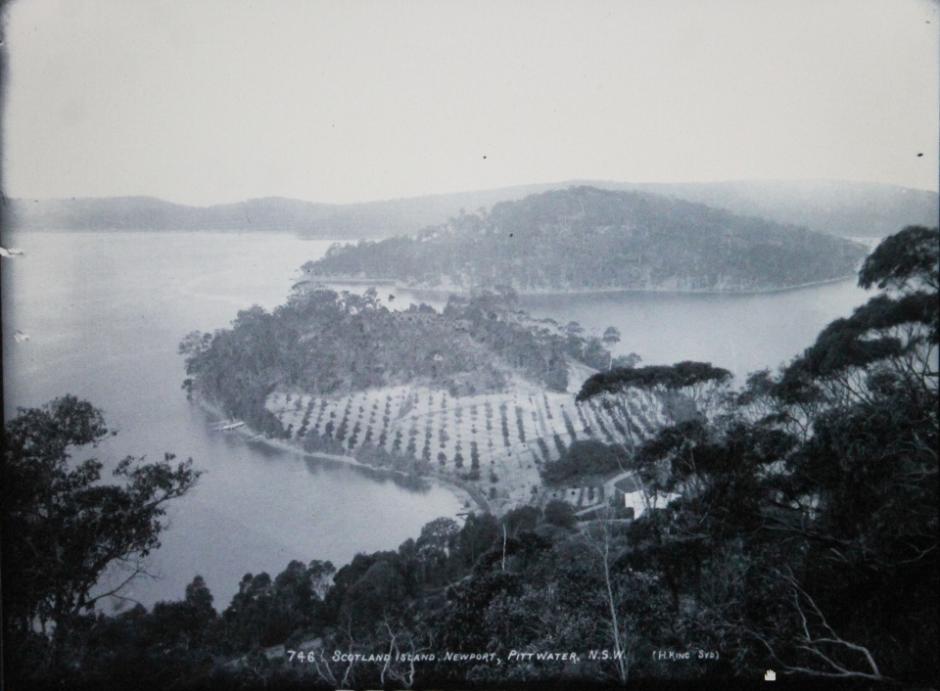
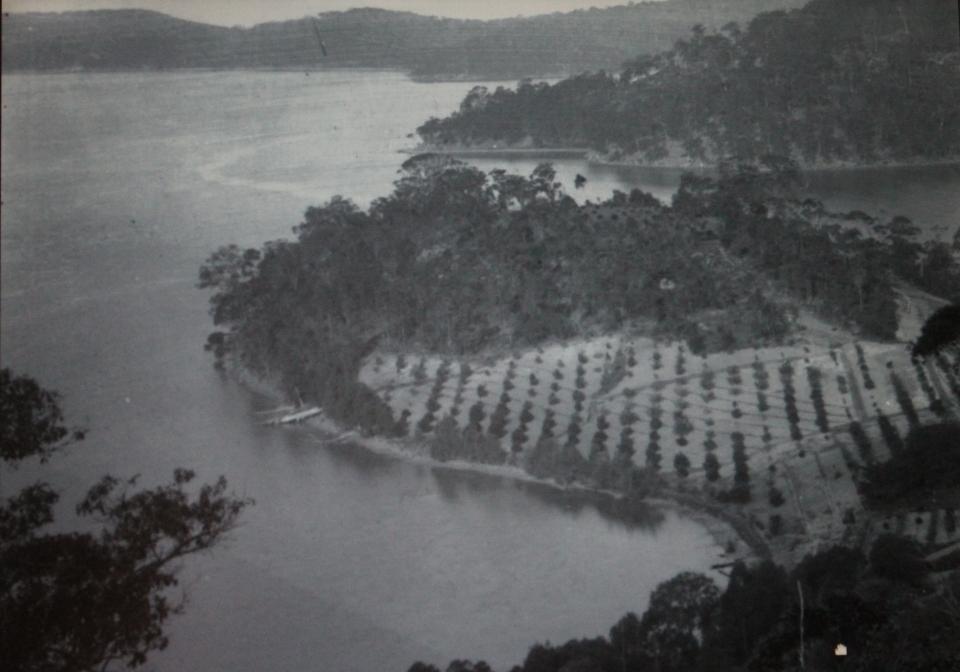
Above: 'Scotland Island, Newport, Pittwater, N.S.W.', Henry King, Sydney, Australia, circa. 1880-1900. ( Rocky Point ) 6/38 Tyrrell Inventory Number, 746, courtesy Powerhouse Museum. Below this - enlarged section from showing boat on beach
Below: 'Orange Orchard, Pittwater', Charles Kerry image, courtesy Tyrell Collection on Flickr, Images No.: 30322/3. (Rocky point/Elvina Bay peninsula) - Below this - other side of Rocky Point showing gap between Scotland Island and Church Point - same series circa 1898
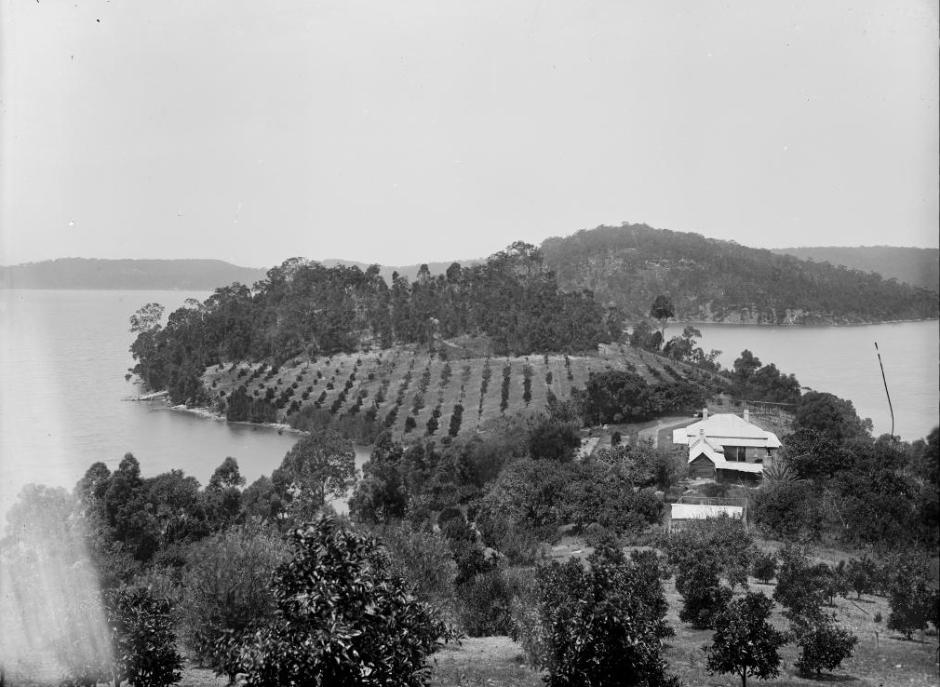
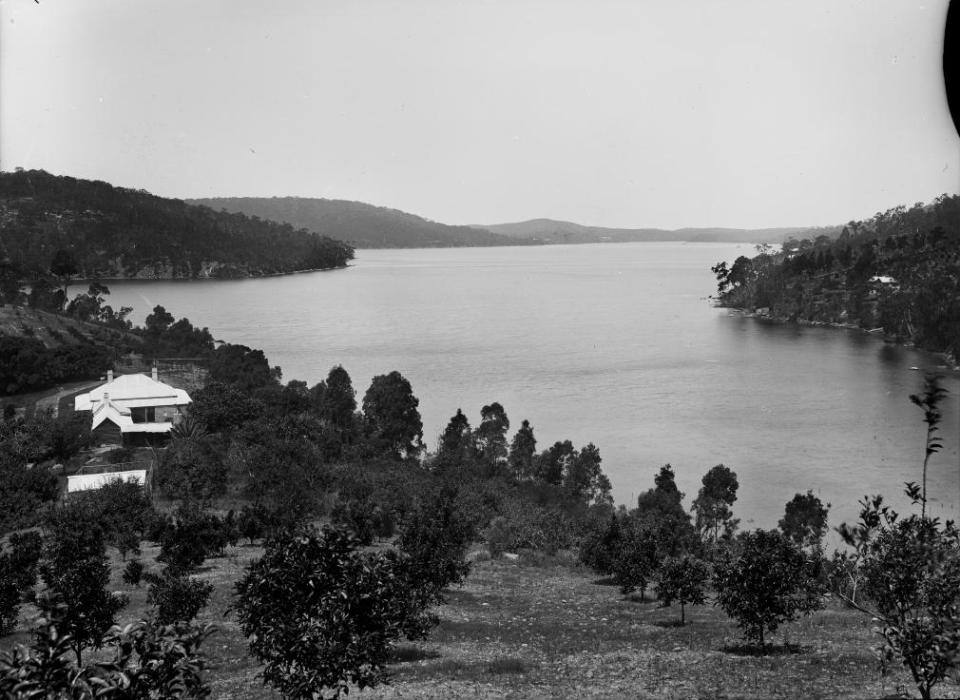
When all roads led to Church Point and all steamers carried beautiful produce from the orchards and farms that prevailed here to Sydney 'town', living in rural Pittwater was one of the best choices for those who wanted to raise a family and one of the best places for 'healthful airs'.
Those who moved or already lived here were blessed with children, several children in some cases. With the 1880 repeal of 'The Public Schools Act of 1866' and establishment of its replacement in 'An Act to make more adequate provision for Public Education. [16th April, 1880.] ' those who were out of sight were nevermore to be out of mind, and this included our offshore bays:
Public School Districts.
His Excellency the Governor Ins , In accordance with the provisions of the Public Instruction Act, and with the advice of the Executive Council. divided certain portions of the colony into public school districts within the meaning and for the purpose of that Act. Over these districts the Governor will hereafter appoint public school boards, each consisting of not more than seven persons, whose duties will be to regularly visit, inspect, and report upon the schools placed under their supervision, to suspend any teacher for misconduct in cases not admitting of delay, and to report immediately the cause of such suspension to the Minister, and to use every endeavour to induce parents; to send their children regularly 'to school, and to report the names of parents or guardians who refuse or fail to educate their children. We understand that the Government are sending circulars throughout the colony inviting persons known to be qualified to act as members of school boards. The clause rendering I t is obligatory upon the parents or guardian of children between the age of six years and fourteen years (and unless just cause for exemption can be shown) to send their children be school not less than 70 days in each half year, will come into force after the expiration of three months from the passing of the Act, and of course into practical effect six months after that.The school districts were published in yesterday's Gazette, and are as follows —
No. 7.— County of Cumberland, parishes of Broken Bay, Gordon, Manly Cove, Narrabeen. and Willoughby. To include Greenwich, Lane Cove (eastern aide), St. Leonards, Manly. Middle Harbour, Mossman's Bay, Pittwater, and Solitary Island. Public School Districts. (1880, July 31).Evening News (Sydney, NSW : 1869 - 1931), , p. 5. Retrieved from http://nla.gov.au/nla.news-article108747080
Under this Act:
22. I n remote and thinly populated districts where no Public School may exist the Minister may establish schools which shall not be classed as fully organised but as provisional only under regulations for that purpose to be approved by the Governor Provided that in all such schools the course of instruction shall be wholly secular and that all such schools shall be subject to the same control and inspection as are prescribed for Public Schools Provided further that so soon as twenty children shall have been in regular attendance at any such school for three months the said school shall be converted into a Public School.
23. In districts where from the scattered state of the population and from other causes it is not practicable to collect a sufficient number of children to form a permanent school the Minister may appoint itinerant teachers under regulations to be approved of by the Governor.
In August 1880 an article title 'Lane Cove and Pittwater - by Our Travelling Reporter' relates a petition being presented for the establishment of a school at Church Point by one of the gentlemen responsible for establishing a chapel there:
Lane Cove and Pittwater.
(BY OUR TRAVELLING REPORTER.)
....Pushing on from the land of "oranges and lemons," I took the Pittwater road, as I had heard much of the scenery to be found at the latter place, which I found to be not over estimated. My instructions were to keep close to tho telegraph poles and I should find myself at length safe at my destination. I do not know whether it was owing to the uncertain character of the road, or rather track, or from the frequency with which the poles took erratic flights into the bush but I found my journey far more difficult than had supposed. The scenery, however, was undeniable. I lunched at the top of a hill, which commanded a magnificent vista of several smaller hills and dales, bounded by the majestic Pacific, which lay in silent beauty, glistening in the sunlight, at some considerable distance. The soil all around seemed only to wait for the hand of man to burst forth into such frightfulness as that I had just left behind me.
About 12 miles on, as well as I could judge, while crossing the ridge of a hill, I was somewhat startled to observe tho telegraph wire trailing on tho ground, putting my quadruped and myself in imminent danger of an overthrow. Looking around, I counted about half a dozen posts, evidently struck by lightning, presenting a most desolate appearance. That is a matter I must also commend to the notice of the post-office people, and if not remedied I shall not be surprised to hear of communication between Sydney and Barranjoey being suddenly interrupted. After passing another mile, or so, the scrub seemed to grow denser every step, almost obliterating the track. The friendly posts had also disappeared-presumedly owing to another attack of the lightning. However, to make a long story short, I found it necessary to got off and lead my horse, to prevent missing tho way altogether, and was excessively and disagreeably surprised, soon after, to find myself in tho middle of the scrub, half way down a mountain side, the treacherous track having completely disappeared. However, there was the sea in sight and I knew I should find some one or other on the shore, and I was not disappointed. I soon came across some houses, which I afterwards ascertained to be Pittwater, and found there the ever ready, courteous hospitality that always awaits tho belated wayfarer in rural New South Wales.
After partaking of a hearty meal, and satisfying myself that my horse was doing tho same, I strolled around to make a sketch or two. And, truly, it was a subject meet for any artist's pundit. There was the lighthouse at the head of Broken Bay just visible in the distance, six miles away, and tho incoming Pacific rolled in through a channel half a mile wide at its nearest part to me, watched by hills covered with verdure, and forming at length into a lagoon some three miles or so long, to the right of which I saw the embryo township of Newport, to which place the Kembla took over 400 people Iast Queen's birthday. Newport is only represented by one house at present, but tho site appeared a peculiarly eligible one for a township.' However, I shall speak of it in another place more fully. At the other end of the lagoon is a Wesleyan church, a tiny neat structure, built on a gentle declivity overlooking the water. Just across the water is Scotland Island, of some little like, rising to some considerable height above the water. Only one house, I believe, is there, the lady inhabiting it being termed the Queen of Scotland Island. Just below, in the bay, was a little sailing vessel engaged in the wood traffic between Pittwater and Sydney.; I stayed to make a sketch, and as the shadows of night were falling fast, I betook myself to my quarters.
A petition was being got up there, having for its object the establishment of a public school in that district. Some 20 signatures I saw in the hands of Mr. M'Keown, who will forward the document to Sydney. As the Wesleyan church will answer temporarily for the purpose of a school, I do not imagine the Department of Public Instruction will hesitate to take pity on this out-of- the-way corner of the colony, and send up a, teacher as soon as possible. Early next morning;. I bade farewell to Pittwater, and with the help of a guide found the right track and came back the: way I went, which of course considerably resembled my going. Taking my time returning, I arrived in Sydney a day or two afterwards. … ' " Lane Cove and Pittwater. (1880, August 28).Australian Town and Country Journal (Sydney, NSW : 1870 - 1907), , p. 18. Retrieved from http://nla.gov.au/nla.news-article70947110
In The SCHOOLS at Church Point, Peter Altona and Sue Gould list 10 boys and 12 girls needing a teacher and school from the Wilson, Fahl, Oliver, Johnson, Baker, Turner, Carrall (Cario) and Wilson Snr. families.
A later article relates some of the names of families already living in this part of Pittwater who were behind the building of a church that would be used as the first schoolhouse;
AN HISTORIC CHURCH. Church Point Memories.
(BY P.W.G)
With reference to "J E C's" very interesting letter in a recent issue of the "Herald," I would like to add a little further information, and, at the same time, to correct a small error that has been made to the effect that, "so far as appears, the church was then (1882) the only church building of any denomination on the seafront between Manly and Gosford. " St John's Church of England, Pittwater, on the headland near the 11-mile peg, was the first house of prayer in that district, having been opened on September 21, 1871, and was referred to as follows:
"This small church was situated quite in the wilderness, being the first erected in that part of the colony "
The erection of the little Methodist Church was through the efforts of Mr. George McIntosh and Mr William Henry McKeown, who conducted services at Bayview, under a tree. This prompted Mr. William Oliver, an early settler of this district, to give one acre of land for 10/ to the following gentlemen, as joint tenants, as per the Certificate of Title, dated November 8, 1871: - George McIntosh, William Oliver, James Jones, Thomas Oliver, John Alderton, William Baker, all following the occupation of farmers, and residing at Pittwater, and William Henry McKeown, of Lane Cove, also a farmer.

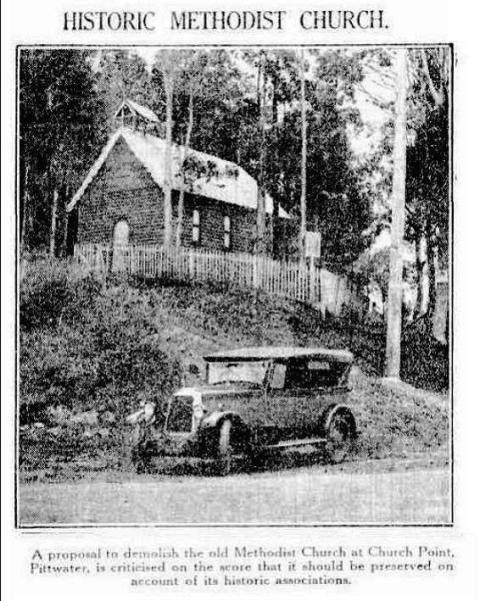
The little church was erected on this land in the year 1872 for the sum of £60, and the point derives its name from this little wooden house of worship (Church Point though in many early records is spoken of as Chapel Point). In the cemetery lie many pioneers who passed away about half a century ago, and such a place enkindles in one's memory the lines of Gray's "Elegy" -
"Each in his narrow cell for ever laid,
The rude forefathers of the hamlet sleep "
Right: HISTORIC METHODIST CHURCH. (1930, March 19). The Sydney Morning Herald(NSW : 1842 - 1954), p. 16. Retrieved from http://nla.gov.au/nla.news-article16634674
The statement of "JEC" that the minister could only visit this church about once a quarter accounts for the burials in this God's Acre being taken by the Rev R S Willis, M.A. Incumbent of St Matthew's Church of England, Manly, up to 1890, and therefore the records of these burials are contained in the Church of England burial register at Manly. This church was used in the week days from May, 1884, until 1888 as a Public school, and known as the Pittwater Public School under the charge of Mr S Morrison, who now resides at Manly. It was on July 19, 1887, that the late Sir Henry Parkes paid a visit to the school in this church building and signed the school's visitors' book. It is to be trusted that the demolition of this church will not be proceeded with, but that it will be restored, and again used for public worship, as the population is growing, and the nearest church is three miles away. This will save this historic place from going into oblivion. I have approached the church authorities with the hope that something may be done at the eleventh hour; even five members of my society (the Manly, Warringah and Pittwater Historical Society) having approached me to the effect that they are willing to spend a few Saturdays, if a conveyance can be provided to help to restore this building. I close with the following appropriate words of Scripture -"Remove not the ancient landmark which thy fathers have set." AN HISTORIC CHURCH. (1930, April 5). The Sydney Morning Herald (NSW : 1842 - 1954), p. 9. Retrieved from http://nla.gov.au/nla.news-article16639396
Samuel Morrison was not the first teacher at Church Point, in THE SCHOOLS at Church Point, by Peter Altona and Sue Gould, Mr. Morrison is stated to be the third with the first commencing in early 1881.
The first was a Miss Martha Perry, who, having completed her training at Richmond Public School and being appointed to the small school at Pittwater by the Department of Instruction, begins at the Pittwater Provisional School in the church premises on 23 March 1881.
The Inspector’s Report upon Miss Martha Perry, Richmond, dated 18 Sept 1880 states: 20 years, unmarried, ability to Read and Write – Very Fair, Miss Perry gives promise of becoming a very useful Teacher of a Small School. (NSW State Records) [1.]
The second teacher was Matlda Cannnan, born 1862 in Newtown, a young lady who was teaching at Concord Provisional school in 1880, where her family resided. The eldest daughter of Henry Dexter Cannan, a Clerk at what was then called the 'Lunacy Department', had a one year tenure, before returning to more 'urban' places - marrying a few years later and having children of her own:
PUBLIC SCHOOL TEACHERS The undermentioned teachers have been appointed to the Public and Provisional schools specified in connection with their respective names- Provisional Schools – Matilda Cannan, Pittwater PUBLIC SCHOOL TEACHERS. (1883, May 26). Freeman's Journal (Sydney, NSW : 1850 - 1932), , p. 9. Retrieved from http://nla.gov.au/nla.news-article110557837
Matilda resigns on March 31st, 1884. A day later, April 1st 1884, the school is declared a Public one.
Samuel Morrison began teaching in the little church on May 1st, 1884, describing his arrival in "Early Pittwater Reminiscences" Manly, Warringah & Pittwater Historical Society, 16th May 1929, as:
"I was appointed teacher at Pittwater Public School on 1st May, 1884. The coach which was run by W. Boulton, Newport, was timed to leave Bagnall’s Hotel, The Corso, Manly at 4 pm on Sunday for Newport. The men employed at Von Beren’s Powder Works were returning by that coach which collected passengers at the livery stable behind the Steyne Hotel and although the driver had promised to pick me up, he went off as soon as the coach was crowded, thus leaving me no alternative but to walk to Pittwater – a distance of thirteen miles.
After passing the Manly Lagoon, I met no one, and passed only two houses that were occupied – Mrs Malcolm’s at Brookvale and Miss Jenkins at Collaroy. On nearing Narrabeen Lagoon I was overtaken by a man in a spring cart, whom I stopped to make inquiries as to the whereabouts of Pittwater. He told me that he was going that way and would give me a lift. This man was Johnny Collins, an old identity of the district, who kept a boarding house at Newport where Miss Scott now caters for the public.
Next morning Mr Collins rowed me over the Bay, and landed me where Bayview Wharf now stands. I had a walk of one and a half miles to Church Point, where the school was held in the little wooden church."
Mr. Samuel Morrison, Teacher, Provisional School, Pittwater. Government Gazette Appointments and Employment (1884, May 27). New South Wales Government Gazette (Sydney, NSW : 1832 - 1900), , p. 3425. Retrieved from http://nla.gov.au/nla.news-article221672305
Church Point at this time was becoming busier - the Prospector powder hulk was soon to be moved to a place just off Woody Point in 1884 and a Post Office had been opened in the Roche store at Bayview in 1882. The safe landing of little people needing to get to school became a priority for the farming families - as a few articles around this time speak of drownings where boats have been capsized or the need to rescue those who have mishaps on the estuary:
The names of the persons who were in the boat which was capsized in Broken Bay on the evening of Monday, 11th instant, were as follow-.-Joseph Medina, George Cobb, John H. Phillips, and Mary Ann Phillips. Both Cobb and the woman Phillips were drowned. The body of the latter was recovered, and a magisterial inquiry held, when a verdict was returned to the effect that Mary Ann Phillips was accidentally drowned through the upsetting of a boat in Pittwater. NEWS OF THE DAY. (1881, April 20). The Sydney Morning Herald (NSW : 1842 - 1954), , p. 5. Retrieved from http://nla.gov.au/nla.news-article13476545
Another deputation puts forward what is needed and why:
DEPUTATIONS. THE NARRABEEN-ROAD.
A deputation, consisting of the Mayor of St Leonards, Dr Tibbit's, and several other gentlemen, waited upon the Hon. Alexander Stuart, Colonial Secretary, yesterday, to request that the Narrabeen-road from Manly to Pittwater be put in a proper state of repair, and that a jetty be constructed on Church Point at Bayview, Newport. The road, it was represented, is now in a very bad condition, and if it were put into proper order it would open up one of the most beautiful districts in the colony. The jetty was required for the benefit of children going to school and persons attending church. The deputation also asked for a bathing place.
Mr. Stuart said he was quite aware that the road had been in a very bad condition, but it was gradually, perhaps rather too slowly being made, and as soon as a bridge was carried across Narrabeen the work on the other side must follow in a matter of course. He would give instructions to have the road examined specially, and reported upon to him during the ensuing week, and he would take an opportunity of visiting the locality and seeing what further could be done in the what further could be done in the way of relief. In regard to the jetty he would give the matter consideration but while the Government might erect a wharf he thought the inhabitants ought to construct a bathing place. The next thing likely to be wanted by the residents would be that the Government should go and wash them. DEPUTATIONS. THE NARRABEEN-ROAD. (1883, June 2). The Sydney Morning Herald (NSW : 1842 - 1954), p. 9. Retrieved from http://nla.gov.au/nla.news-article13536041
The following tenders have been accepted by the Government :-Turner and Collins, contract 31M. M'Gurr's Creek, road Pittwater,Government Gazette. (1884, January 5). Australian Town and Country Journal (Sydney, NSW : 1870 - 1907), , p. 14. Retrieved fromhttp://nla.gov.au/nla.news-article71007271
THE following tenders were opened by the Tender Board at the Public Works Department yesterday: Wharf at Church Point, Pittwater.NEWS OF THE DAY. (1884, December 10). The Sydney Morning Herald (NSW : 1842 - 1954), p. 9. Retrieved fromhttp://nla.gov.au/nla.news-article13581494
Accepted tenders: William Boulton, construction of wharf at Church Point, Pittwater. GOVERNMENT GAZETTE. (1884, December 31).The Sydney Morning Herald (NSW : 1842 - 1954), p. 6. Retrieved from http://nla.gov.au/nla.news-article13578833
The completion of the Government wharf at Church Point, Pittwater, will prove a great benefit to the residents in that district. The wharf is a substantial wooden structure, and boats drawing 11 feet of water will be able to come alongside at high tide. The population in the neighbourhood of Pittwater is rapidly increasing, and it is understood that the Government intend building a Public school to accommodate 50 pupils. Fruit-growing promises to be the leading industry in that locality. A considerable area of land is being planted with fruit trees.NEWS OF THE DAY. (1885, July 4). The Sydney Morning Herald (NSW : 1842 - 1954), p. 11. Retrieved fromhttp://nla.gov.au/nla.news-article13592258
The above reference to the construction of a new premises for the school follows on from another letter, of August 1884 (signatories.H. McCulloch, Frederick Chave, Charles Johnson, J. Bens, Mrs J. Baker, Thomas Wilson, James Shaw, William Baker, Thomas Oliver, Albert Black, Friedrich Fahl, J. Carrio and A. Wood.) and another in June 1886. This 'News of the Day' appears a few months after the timeAlbert Black, Coastwaiter of the Broken Bay Customs Station at Barrenjoey, who had children, sells one acre of his land for the purpose of having a proper schoolhouse and premises for the schoolteacher - his offer accepted May 7th, 1885.
Before we leave this first little school on our western shores, it seems from the article 'At Church Point', November 1922 (below) that a young John Roche was an early student - a few words from those who also attended,perhaps as part of a writing letters exercise - and worth noting these appear in the Australian Town and Country Journal - plus an end of year 'prize giving':
Pittwater, Broken Bay.-I am a little boy 11 years old. I come to school in a boat. I have plenty of school-mates, and we have fine fun. My amusements in the evening are playing about and boat sailing. I have a nice little schooner, and she sails very well. This is a very nice place down here, and I would not like to leave it. . -ALFRED.
[Your writing is very good.]
Pittwater, Broken Bay.- I am only a child, but I must write you a letter, and I have seen none from Pittwater yet. We have a public school. The school is held in the church. I believe we shall have a new one. I have a young pet opossum; he will climb up your back, over your shoulders, as he is very tame. It is funny to see him hang by his tail. My father has a large orchard, and we have fruit nearly all the year round. GRACE. The Children's Letter Box. (1886, July 3).Australian Town and Country Journal (Sydney, NSW : 1870 - 1907), , p. 30. Retrieved from http://nla.gov.au/nla.news-article71064727
Church Point, Pittwater, was on the 9th instant the scene of unusual festivity, the occasion being the distribution of prizes to the children attending the Public School.
Upwards of 150 of the residents were present, also visitors from Manly and Sydney. Dr. Tibbetts of Manly, undertook the office of distributing the prizes, which were numerous and valuable. After the prizes were distributed, the children indulged in the usual games – cricket, foot-racing, and rounders, which were continued till evening when a most pleasant day was concluded with the usual loyal cheers,three hearty cheers also being given in honour of the family of Mr Chave, of Pittwater, whose efforts mainly contributed to the successful carrying out of the day’s programme.” NEWS OF THE DAY. (1886, November 12). The Sydney Morning Herald (NSW : 1842 - 1954), , p. 7. Retrieved from http://nla.gov.au/nla.news-article13620170
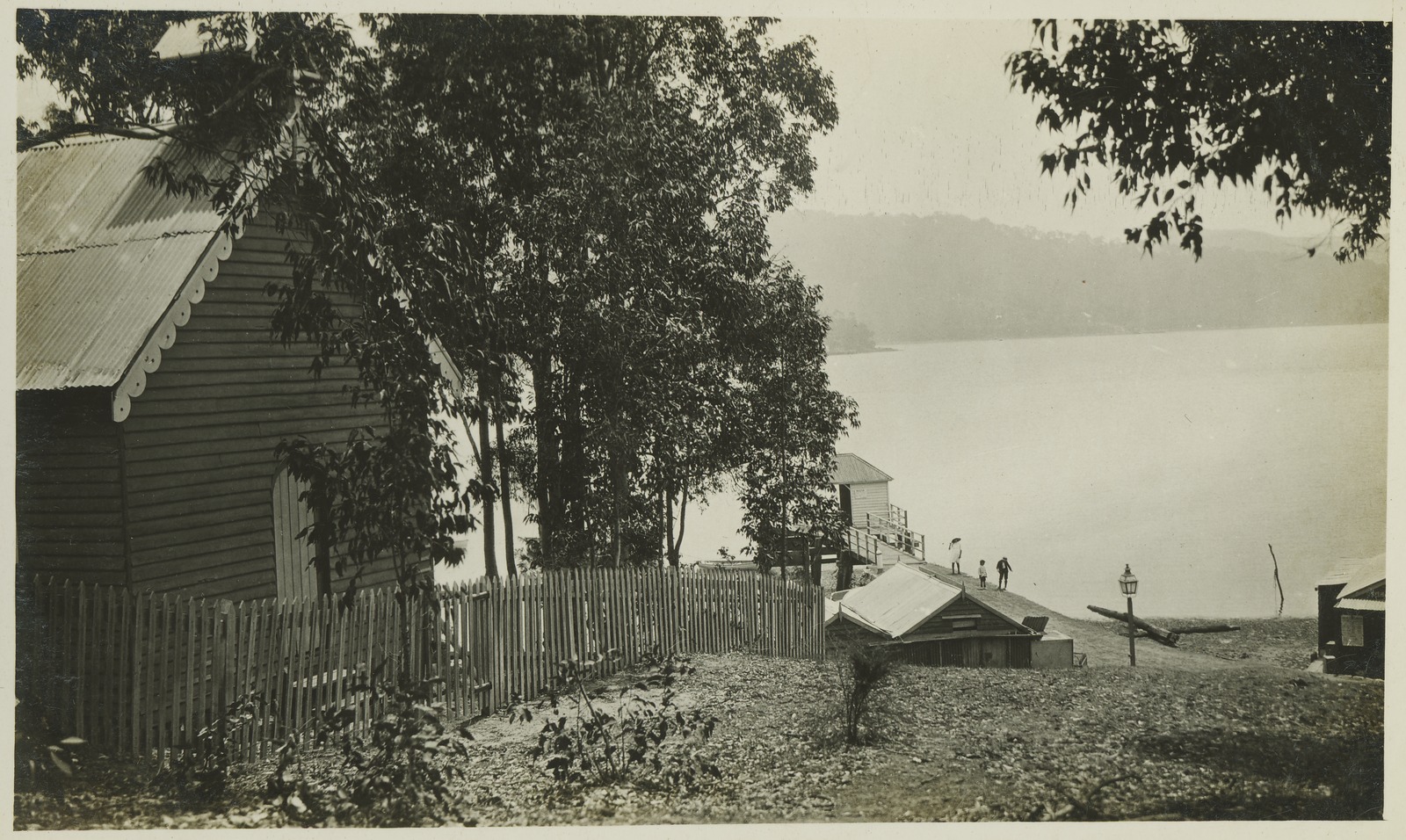
Above: 'Church Point, Pitt Water - 20 minutes from Sydney' by A. J. Vogan (Arthur James), 1859-1948, [circa. 1910 - ca. 1915]. Courtesy State Library of Victoria. Image H82.254/8/29 - showing the chapel; Church point was named for - see Methodist Church at Church Point History - 'A Church at Church Point!'
On February 25th, 1887 an additional 15 2/4 perches were resumed and added to the public school lands at the northern end of W T Cape's (Cape's Flat) acreage, originally part of George Weller's land, and Tenders called for the construction of the school building. The new school building and residence was situated between where Quays marina is now and Church Point.:
Resumption of Land at -
Pittwater for Public School site. Department of Public Instruction, page 1318. Index page (1887, March 31). New South Wales Government Gazette (Sydney, NSW : 1832 - 1900), , p. xix. Retrieved from http://nla.gov.au/nla.news-article219936071
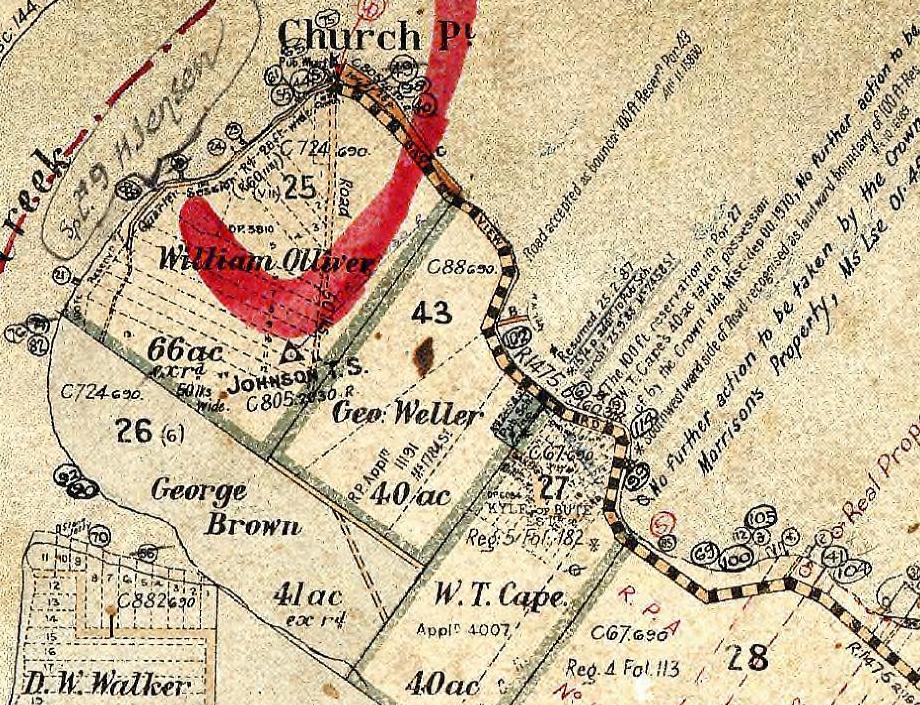
Section from transferred docs. from earlier map, this one dated 1906 Map from NSW Maps Online records showing school placement
With or perhaps due in part to having a place to provide for a wife and family, Samuel Morrison marries a local girl:
Marriages.
MORRISON-CHAVE.-May 13. at Carlton Villa, Pittwater, by Rev. R. T. Willis, Samuel Morrison, late head master of Saunders-street School, Belfast, to Emma, eldest daughter of F. Chave. Family Notices (1887, May 20). The Sydney Morning Herald (NSW : 1842 - 1954), , p. 1. Retrieved from http://nla.gov.au/nla.news-article13659178
F. Chave is the same Frederick Chave whose name heads up the petition of 1886. His passing in 1898, and being interred in the church grounds at Church Point, may be the 'holiday' a then 13 year old John Roche refers to. From: Newsletter for Offshore Residents of Pittwater, Australia Volume 9, Issue 182 November 2006 (Pittwater Offshore Newsletter - PON):
An early pioneer in Pittwater, Frederick Chave, developed three properties on points between Towlers and Lovett Bays with the evocative names of "Carlton Villa", "Brighton Villa" and "Bleak House" named after his favourite book by Charles Dickens which had been published in 1853.
Near the north entrance to Lovett Bay, Mr. Chave had the finest orchard in the district. One shilling (10 cents) bought a bucket of grapes grown from a "dingle" or area of hollow ground between his house and the road. He also grew figs, lemons, oranges and olives. When he died in 1898 Frederick Chave was buried in the little churchyard at Church Point. Other members of his family settled in Bayview.
Leicester Warburton.
Mr. Chave had previous experience in getting schools working:
Public Schools. — The undermentioned gentlemen have been appointed to form the Public School Board in connection with the Public School at Baulkham Hills, viz. : —
Mr. Andrew Louis M'Dougall, J.P., Messrs. Frederick Chave, James Tamsett, James Pearce, and James Dellow. THE GOVERNMENT GAZETTE. (1874, June 6). The Sydney Mail and New South Wales Advertiser (NSW : 1871 - 1912), , p. 721. Retrieved fromhttp://nla.gov.au/nla.news-article162484584
Sydney, 24th June, 1887
TENDERS FOR WORKS IN CONNECTION WITH PUBLIC SCHOOLS.
TENDERS will be received at this Office for the works specified in the Schedule hereunder, up to 10 o'clock a.m., on the X various dates set forth in the second column.
Tenders are to be addressed, to the " Acting Under Secretary, Department of Public Instruction, Sydney," and endorsed u Tender for [Here insert the name of School, and the work to-which the Tender relates],
Description of Work to be Tendered for.
Pittwater, Brick Buildings – will be received up until July 6th, Department of Public Instruction, Sydney… TENDERS FOR WORKS IN CONNECTION WITH PUBLIC SCHOOLS. (1887, June 24).New South Wales Government Gazette (Sydney, NSW : 1832 - 1900), , p. 4154. Retrieved from http://nla.gov.au/nla.news-article224299027
The Tender is awarded to Frank Collins, who may be a son of John Collins Snr., born in 1855:
Tenders Accepted. — The undermentioned tenders in connection with Public schools, have been accepted by the Government, viz. : —Pittwater, new buildings, F. E. Collins, £615; Government Gazette. (1887, July 30). The Sydney Mail and New South Wales Advertiser (NSW : 1871 - 1912), , p. 244. Retrieved from http://nla.gov.au/nla.news-article165224777
The Memorandum from the Architect to the Under Secretary dated 22 February 1888 states, “I have the honour to report that the Public School Buildings … are completed and ready for occupation.” (State Records NSW). “In 1888, a fine brick school was erected on modern lines and a good residence was built for the teacher.” (S. Morrison). The teacher’s residence contains three rooms, kitchen and washhouse.(State Records NSW)
A plan of the school shows a classroom measuring 34 ft x 16ft externally and containing nine desks (each 9ft) set out in three rows and a fireplace.[1. and 2.]
The move and excitement may have brought on labour – either way a good omen for a new school occurs soon after the completion of construction:
MORRISON.— February 23, at her residence, Public school, Pittwater, the wife of Samuel Morrison, of a daughter. Family Notices (1888, March 10). The Sydney Mail and New South Wales Advertiser (NSW : 1871 - 1912), , p. 546. Retrieved fromhttp://nla.gov.au/nla.news-article164358039
Ethel is the daughter born in 1888. Samuel and Emma Morrison have Frederick (born 1889), Lillian (born 1891) and Percy (born 1893).
Soon after the school's opening, a way to raise funds for sports equipment is recorded:
CONCERT AT PITTWATER PUBLIC SCHOOL.
A concert took place in the Public school, Pittwater, on Saturday evening last, which was a great success in every way. The proceeds of the concert were to purchase a croquet set for the girls and a cricket set for the boys. The programme consisted of 30 items-songs, duets', recitations, readings, and instrumental music, all of which passed off most creditably.
Much valuable assistance was rendered by the following ladies and gentlemen of Sydney and the district:-Miss Buchanan, Miss Alice Chave, Miss Chave, Miss Elsie Chave, Miss Fahe, Miss Gracie Green, Mr. Aitken, Mr. Giles, Master A. Chave, Mr. F. Chave, Mr. F. Beverley, Master F. Faho, Mr. Cox, Mr.' Scott, and others. The school children sang, with great gusto, "The harp that once," "A. B. C," "The Bay of Biscay," and "Home, Sweet Home."
The school was tastefully arranged with Chinese lanterns and lamps, and was well attended by the residents and well known gentlemen from Sydney. The concert terminated with the National Anthem shortly after 9 o'clock. CONCERT AT PITTWATER PUBLIC SCHOOL. (1888, June 19). The Sydney Morning Herald (NSW : 1842 - 1954), , p. 8. Retrieved from http://nla.gov.au/nla.news-article13689447
Samuel Morrison, soon after the school opens, begins advertising for student boarders, while one of his students, possibly the 'Alfred' who wrote to the children's column above, does well elsewhere:
PITTWATER PUBLIC SCHOOL near Manly.
There are vacancies at the above School for two Boys (Boarders) terms £30 per year. Apply to the Teacher S MORRISON. N B -Pittwater is one of the most healthy resorts in the colonies. Advertising (1889, January 12). The Sydney Morning Herald (NSW : 1842 - 1954), , p. 3. Retrieved from http://nla.gov.au/nla.news-article13710019
PITTWATER PUBLIC SCHOOL, near Manly. There is a vacancy for a Boarder (boy) at the above School. Every home comfort and attention. Terms £36 a year. Apply to the teacher, S. MORRISON. N.B.-Pittwater is one of the healthiest resorts in the colonies. The school is situated on the edge of Broken Bay. Advertising (1889, January 24). The Sydney Morning Herald (NSW : 1842 - 1954), , p. 12. Retrieved from http://nla.gov.au/nla.news-article13711610
PITTWATER PUBLIC SCHOOL, near Manly. VACANCY for one boarder boy; terms £9 per quarter ; every home comfort and attention ; table liberally supplied with fruit and vegetables. Quarter commences on date of entrance. S. MORRISON, Teacher. N.B.-Pittwater is one of the healthiest resorts in the colony. Advertising (1889, August 14). The Sydney Morning Herald (NSW : 1842 - 1954), , p. 1. Retrieved from http://nla.gov.au/nla.news-article28337276
PITTWATER PUBLIC SCHOOL, near Manly. Vacancy for Boarders (boys). Boys prepared for Civil Service and other exams. Every home comfort and attention. Table liberally supplied with fruit and flesh vegetables. Terms, Including washing, mending, &c, £9 per quarter. Quarter begins on date of entrance. S.MORRISON, Teacher. Advertising (1889, September 19). The Sydney Morning Herald(NSW : 1842 - 1954), , p. 1. Retrieved from http://nla.gov.au/nla.news-article13744996
SYDNEY UNIVERSITY. JUNIOR EXAMINATION.
Subjoined are given the results of the Junior Examination recently held in connection with the University of Sydney. In addition to the pass list, there are given the awards in connection with the prize list. The subjects in which the candidates were examined were grouped in four divisions, the divisions, sections, and subjects being as follows : -Group I. :
Pass list - ... Chave, Alfred Edward, Public school, Pittwater. English history; B; geography, A; English, B; arithmetic, B ; geometry, B. SYDNEY UNIVERSITY. (1890, November 3). The Sydney Morning Herald (NSW : 1842 - 1954), , p. 2. Retrieved fromhttp://nla.gov.au/nla.news-article13799217
A little more regarding Alfred Edward Chave:
From Orchard to Selling Floor : The Story of Queensland's Fruit Trade!
A. E. Chave.
Coming to Brisbane in 1896 Mr A E Chave has one of the oldest established businesses in the fruit trade In Queensland. Born at Baulkham Hills near Parramatta (NSW) his early years were spent about that part of New South Wales. Later his father established an orchard at Pittwater Broken Bay At the age of 18 he joined his brother in the fruit agency business in the Bathurst Fruit Exchange (Sydney) and after three years of market experience he came to Brisbane where he has resided ever since Mr Chave s experience has been availed of as Judge at several district chows and last year he was appointed to the position of Judge at the Brisbane Exhibition of district exhibits and other fruit and vegetable classes In1906 when the Fruit and Produce Ex-change Company was formed and fine premises were erected In Turbot street he was appointed secretary to the company which position he held for several years eventually resigning to take a place on the directorate of the company a position which he still holds.
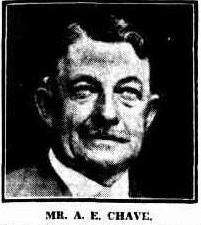 A special feature of Mr. Chave’s business Is supplying fruit orders which arc received from all parts of Australia He was the first to send shipments of pines to Canada successfully An extensive trade Is also carried on with Imports from the Southern States Large supplies are drawn from Tasmania and satisfaction to growers can be gathered from the fact that several clients have been shipping to him
A special feature of Mr. Chave’s business Is supplying fruit orders which arc received from all parts of Australia He was the first to send shipments of pines to Canada successfully An extensive trade Is also carried on with Imports from the Southern States Large supplies are drawn from Tasmania and satisfaction to growers can be gathered from the fact that several clients have been shipping to him
Right: MR. A. E. CHAVE.
regularly for the past 25 years He Is ably assisted In the business by his son Mr Alf Chave Mr Chave has resided In the Wynnum district for 25 years. He occupies the chairmanship of the Manly State school committee, the Wynnum and Manly School of Arts, and also the Wynnum branch of the Country e and Progressive National Party. Although born in New South Wales he is a Queenslander by adoption, and says he looks upon this State as the pick of the Commonwealth. From Orchard to Selling Floor: The Story of Queensland's Fruit Trade. (1932, February 27). The Brisbane Courier (Qld. : 1864 - 1933), p. 7. Retrieved from http://nla.gov.au/nla.news-article21785194
Samuel Morrison takes on new duties:
Colonial Secretary's Office,
Sydney, 7th October, 1892.
HIS Excellency the Governor, with the advice of the Executive Council, has been pleased to appoint the undermentioned gentlemen to be Magistrates for the Colony, viz.:— Morrison Samuel, Church Point, Pittwater; Government Gazette Appointments and Employment (1892, October 7). New South Wales Government Gazette (Sydney, NSW : 1832 - 1900), , p. 8103. Retrieved fromhttp://nla.gov.au/nla.news-article222206531
Some repairs and new structures and a visit from a politician tells us the surnames of some of the families whose children became pupils at Bayview/Pittwater Public school - Peter Altona and Sue Gould's 'The SCHOOLs at Church Point' records all four of the Morrison children as well as others, among them; J.W. Austin, Elsie Baker, Una Chave, Florence and Violet Ireland, the Booth children, Johnsons, Carl Morgan, Roches, Buists, S. Lloyd, and Godbolds:
Department of Public Instruction, Sydney, 28th June, 1892.
TENDERS FOR WORKS IN CONNECTION WITH PUBLIC SCHOOLS.
Description of Work to be Tendered for.
Pittwater—Erection of a Weathershed. Department of Public Instruction, Sydney, and Post Office, Bay view. TENDERS FOR WORKS IN CONNECTION WITH PUBLIC SCHOOLS. (1892, July 1).New South Wales Government Gazette (Sydney, NSW : 1832 - 1900), , p. 5345. Retrieved from http://nla.gov.au/nla.news-article222107986
A 'weathershed' was "a roofed structure giving temporary shelter from the rain, especially in school playgrounds", according to the Oxford Dictionary.
WARRINGAH ELECTORATE.
Mr. Dugald Thomson, a candidate for the representation of this electorate, addressed a meeting of electors at Bayview on Saturday afternoon. Mr. Thomson was accompanied from Manly by Messrs. Alexander Dean, G. S. Littlejohn, Heatherington, Doyle, and J. Duncan. Mr. Thomas Austin occupied the chair, and there was a representative attendance. Mr. Thomson gave his views on the fiscal policy, local government, federation, finance, local option, womanhood suffrage, and other political questions. Mr. Thomson was well received, and on tho conclusion of his address a vote of confidence in the candidate was moved by Mr. W. G. Geddes, seconded by Mr. Frederick Chave.Mr. E. S. Littlejohn and Mr. John Duncan spoke in support of the vote of confidence, which was carried unanimously. WARRINGAH ELECTORATE. (1894, May 1). The Sydney Morning Herald (NSW : 1842 - 1954), , p. 6. Retrieved from http://nla.gov.au/nla.news-article28259638
Tenders Accepted -The undermentioned tenders in connection with Public schools have been accepted by the Government,; Pittwater, improvements, J Boulton, £10 10s 6d, GOVERNMENT GAZETTE. (1894, June 25). The Sydney Morning Herald (NSW : 1842 - 1954), p. 7. Retrieved from http://nla.gov.au/nla.news-article13956936
TENDERS FOR WORKS IN CONNECTION WITH PUBLIC SCHOOLS,
Description of Work to be Tendered for; Pittwater, Bay view, via Manly — Improvements and Repairs. Department of Public Instruction, and Public School, Pittwater. TENDERS FOR WORKS IN CONNECTION WITH PUBLIC SCHOOLS. (1897, September 21). New South Wales Government Gazette (Sydney, NSW : 1832 - 1900), , p. 6757. Retrieved from http://nla.gov.au/nla.news-article222834171
And the end of year concert:
Country News. Pittwater Public School, Bayview.
The annual concert in aid of the prize fund of the above school was held on Saturday evening, 6th instant. Mr Dugald Thomson, M.L.A. presided. There was a large audience. The programme which consisted of songs, duets, recitations violin and auto harp selections, was well rendered by the friends of the children. A vote of thanks to the chairman and those who contributed to make the entertainment a success was proposed by the teacher. (Mr Morrison).” COUNTRY NEWS. (1897, November 12). The Sydney Morning Herald (NSW : 1842 - 1954), , p. 5. Retrieved from http://nla.gov.au/nla.news-article14112404
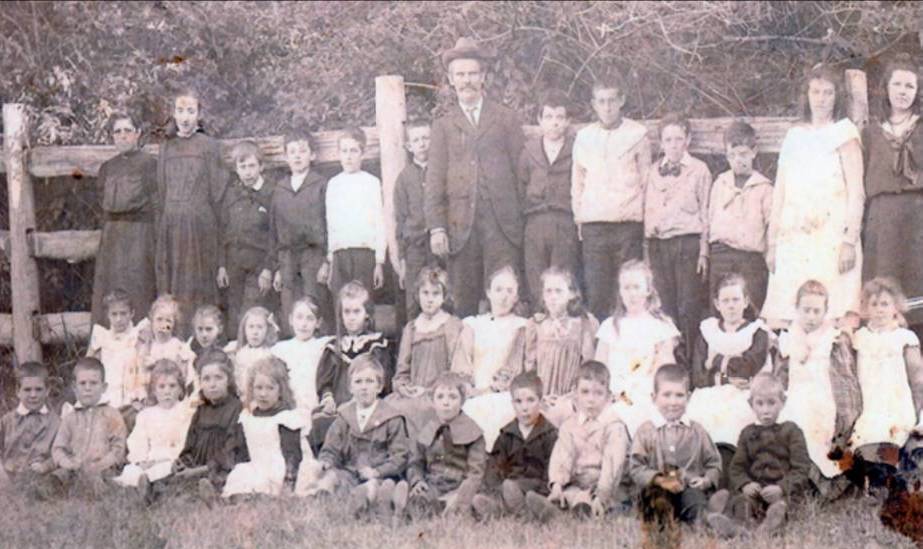
Pittwater Public School - Samuel Morrison with his pupils - circa 1898, courtesy Bob Waterer
Pittwater was going ahead in leaps and bounds - a call for a proper wharf at 'Bay View' was about to me met and parents who have children always want a hospital for their care within reach - then, as now, the community would raise funds to support a hospital:
MANLY HOSPITAL CONCERT.
A concert in aid of the Manly Cottage Hospital, organised by the residents of Bayview and Newport, was held in the Newport Hall on Saturday evening week, under the direction of a committee consisting of Messrs. C. Devlin, Fitzgerald, Booth, Erickson, and Wilcox. The contributors to the programme included Misses Lord, Duffy, Johnson, and Black, Messrs Duffy, Fitzgerald, Booth, and Buist. The financial and artistic success was such that it was decided to give a similar entertainment annually. MANLY HOSPITAL CONCERT. (1899, October 9). The Sydney Morning Herald (NSW : 1842 - 1954), p. 7. Retrieved from http://nla.gov.au/nla.news-article14237617
BAY VIEW PIER. THE OPENING CEREMONY. The opening of the Bay View Pier took place on Saturday afternoon at Pittwater, in the presence of a large and representative gathering. The ceremony was performed by Mr. Dugald Thomson, M.L A.(member for the district), who was accompanied by Captain Millard and Mr. J.J. Cohen, M. L.A , Dr. Cullen. M.L.C , Messrs W. H. Fletcher (Mayor of Manly, J. M. Purves (Mayor of North Sydney), P T. Taylor, Hopkins, Waterhouse, J. Symonds, Vivian, Devlin, Bennett, Watt and others. The party left Sydney shortly after 9 o'clock in the morning for Manly, whence the journey was made to Bay View by special coaches. The drive was much enjoyed, and at its termination the party boarded a steam launch which was in attendance at the pier, and made a trip round Pittwater as far as Barranjoey and back to the wharf. The new wharf is a substantial structure, and has been erected by the Government for the purpose of landing and shipping passengers and produce. The water journey over, the party adjourned to Buist's Hotel, where luncheon was served. The chair was occupied by Mr. P. T. Taylor. A brief toast list was honoured, which included "The Queen," proposed by the chairman, and enthusiastically honoured , “Parliament" proposed by Mr. Hopkins, and responded to by Dr. Cullen and Captain Millard; " The District," proposed by Mr. J. J. Cohen, supported by Mr. J. M. Purves, and replied to by Messrs. J. Symonds and Waterhouse ; " The Member for the District," by Mr. Vivian, and responded to by Mr. Dugald Thomson; "The Visitors," and " The Press." BAY VIEW PIER. (1900, December 3). The Sydney Morning Herald (NSW : 1842 - 1954), p. 8. Retrieved from http://nla.gov.au/nla.news-article14374798
See Bayview Wharf History page
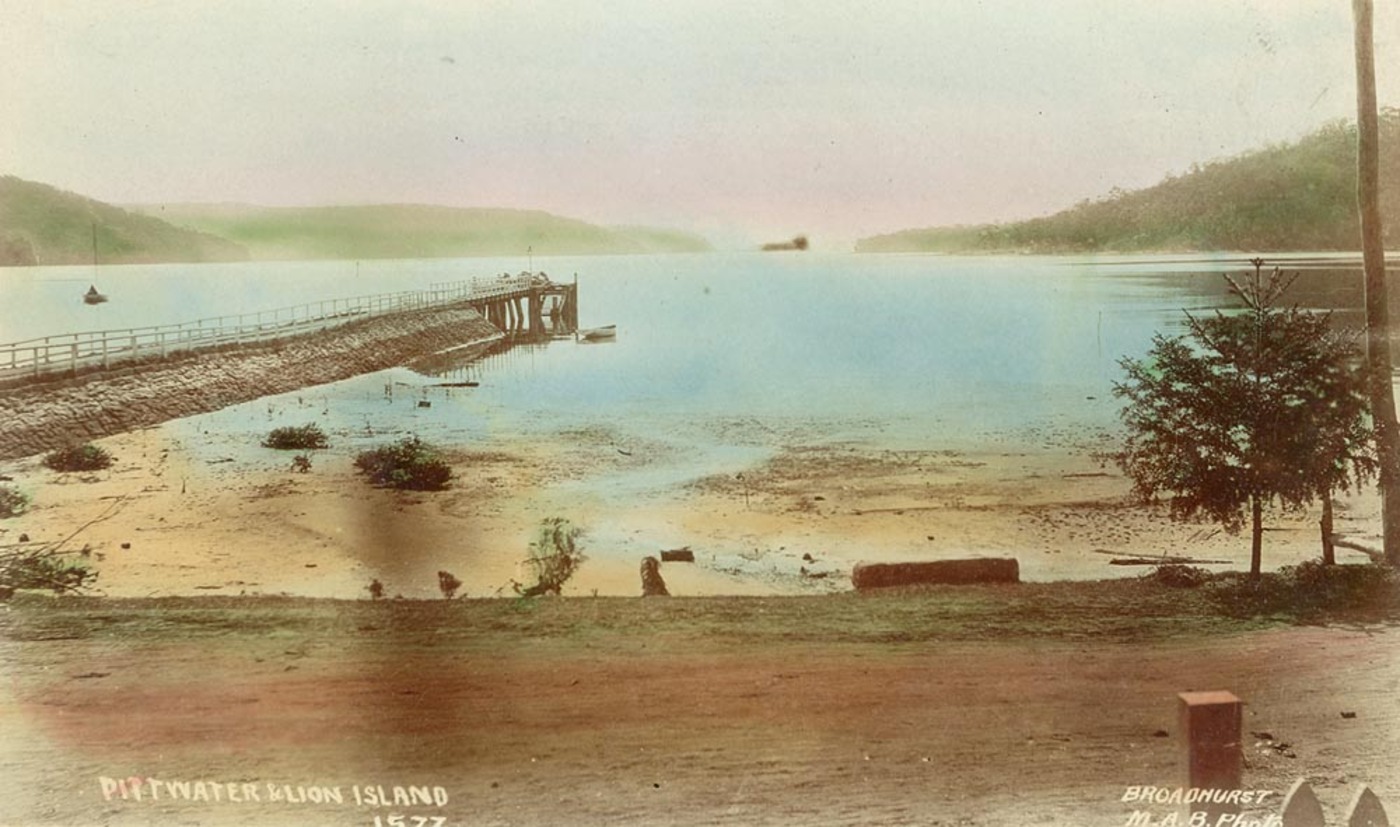
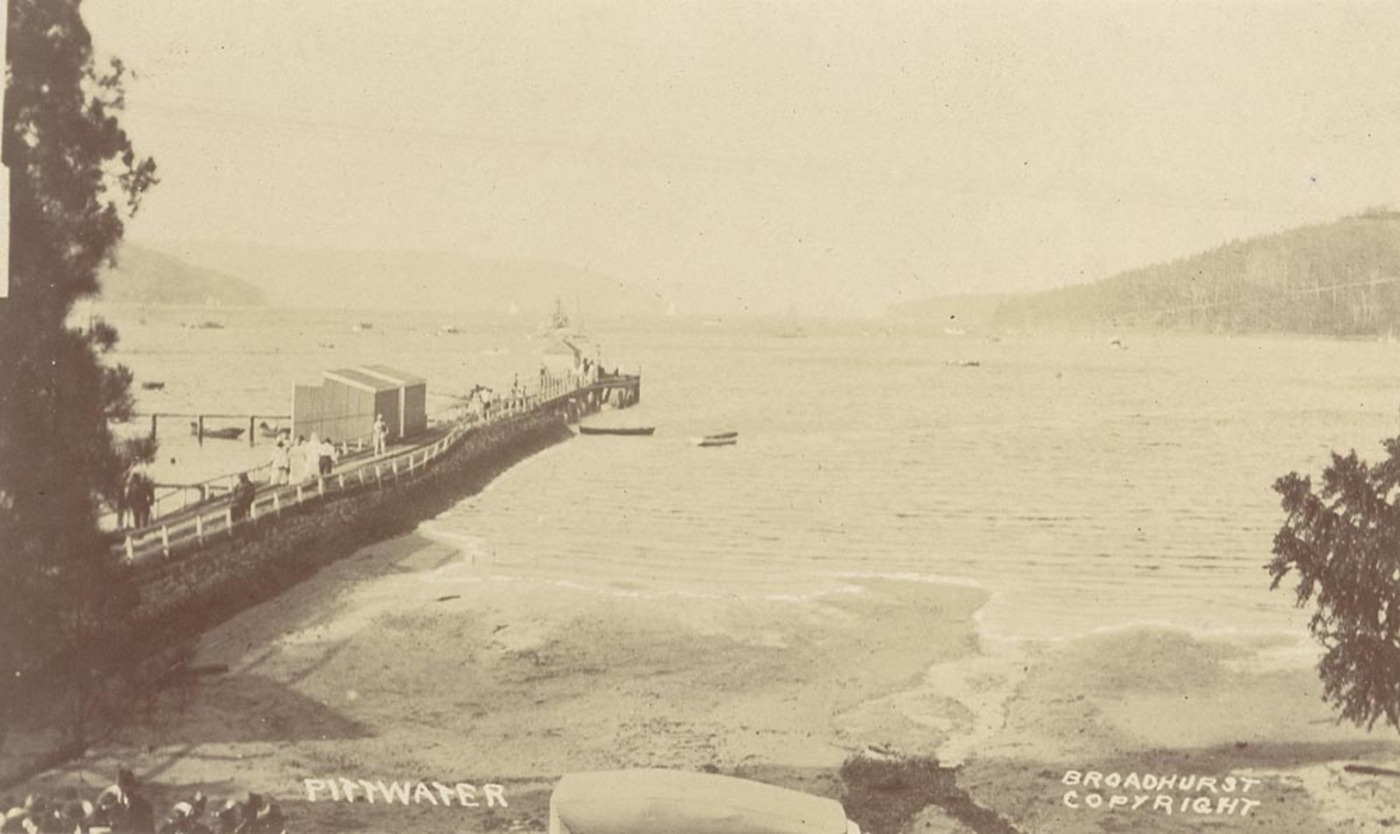
Bayview Wharf, circa 1909. Broadhurst Image 11061661h, courtesy State Library of NSW.
By 1904, when the school began to be called 'Bayview Public School', up to 60 children were attending the school at Church Point-Bayview, many of them coming to school over the waters from bays, The Basin and from Barrenjoey. A safe means for them to get there, year round, became a priority and led to the first school launch and ferry service specifically for children - :
Bayview School Launch.
(See Illustration on this page.)
The Patonga is a motor launch, engaged, morning and evening, of every school day, to convoy children residing at Barranjoey, Careel Bay, and the adjoining district, to ;the Bayview (Central) School. - Pittwater, although one of the most beautiful, interesting, and picturesque bf Nature's gems, is by the very reason of its loveliness, n difficult place to provide with schools. Until quite recently the only way these children could get to either Bayview or Newport Public Schools, was by rowing boat, the distance in some cases being nearly eight miles. It will be seen that only in very fine weather was it possible to attend school, and the result, unfortunately, was that the people, by the peculiarity of their location, were practically debarred tho advantage of our Public Instruction Act.
Numerous requests were made to have more convenient school accommodation for these children (29 in number), but there was this difficulty -That to give all these families anything like equal opportunities, would have necessitated two or three small schools. Early in the present year, the Hon John Perry, then Minister for Education, Instructed Mr. Senior Inspector Lobban to take the matter in hand, and ascertain the best way in which the request could be treated. After exhaustive inquiries had been made by that able, officer; assisted by Mr. S. Morrison, teacher at Bayview Public School, it was proposed to gather together all the children, and take them by launch to Bayview Public School. This idea commended itself to Mr. Perry, and arrangements were made with Mr. William Sykes,- the owner of the Patonga, to give the scheme a fair trial. Tho service was inaugurated in' April, and has been running nearly four months.. As this was one of tho last administrative acts of Mr. Perry, he may feel proud of the result, which is described in departmental reports as "an unqualified success.". This launch is the first and only school launch in Australia. The boat is a distinct departure from the style usually adopted for motor launches. She is 30ft long and 8ft beam, the motive power being supplied by a 5 h.p. Hercules engine. She was built specially strong to withstand the rough sea sometimes experienced in tho bay, and it ls a source of gratification to the department that all through :the recent heavy weather the timetable has been carried out. She is' in charge of her owner, and presents an interesting appearance as she comes each morning, with 20 to 30 children, to Church Point Wharf.
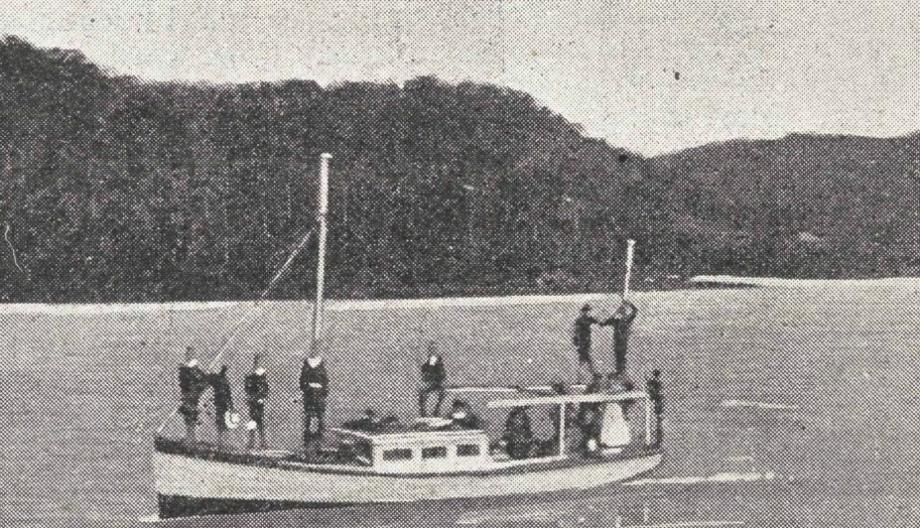
The Bayview (Pittwater) Public School Launch. Bayview School Launch. (1904, August 3).Australian Town and Country Journal (Sydney, NSW : 1870 - 1907), , p. 37. Retrieved from http://nla.gov.au/nla.news-article71512651
Images is from a Newspaper cutting held by the State Library of Western Australia:
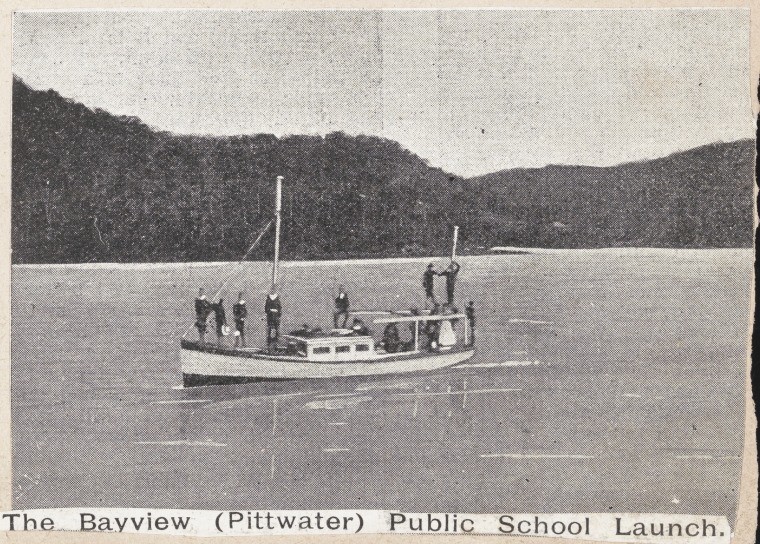
'This image is part of a collection of 69 albums of pictures, postcards, and newspaper cuttings donated to the State Library of Western Australia in July 1961 by the family of the late Mr Miller. Jack Edward Miller was employed as a boatman and cook by the Harbour and Lights Department in February 1902 and spent some time at Breaksea Island lighthouse near Albany.' Call Number U15g.
BAY VIEW PUBLIC CENTRAL SCHOOL.
The report of Mr Lobban senior Inspector, was read at the annual distribution In connection with the Bay View Public central School. This showed that good work had been accomplished and reference was made to the satisfactory working of the school launch - the first experiment of the kind. Short addresses were delivered by Mrs V Anderson, Miss E Pye (Education Department Victoria) and the teacher. The prizes were presented by Mesdames Anderson and Taylor. The principal prize winners were -L Morrison H Newman H Howlett R Howlett J Morrison S Lloyd and M Booth. After refreshments various sports were indulged in. BAY VIEW PUBLIC CENTRAL SCHOOL. (1905, December 20). The Sydney Morning Herald (NSW : 1842 - 1954), , p. 12. Retrieved from http://nla.gov.au/nla.news-article14735150
Although the 'With the Children - Homeward Bound' article below speaks of the launch continuing its service, the children are being ferried to Newport if they need to access school by water.
In June 1905 Samuel and Emma Morrison wish to be have access to schooling that will suit their children at the age they are then - some of the orchard owners are moving closer to Mona Vale as well as people coming into the area and snapping up affordable blocks of green by the sea air, necessitating the provision of a school here, as one advertisement for the Rock Lily estate claims (under Extras - October 1906 'WARRIEWOOD FARM BLOCKS')
MONA VALE SCHOOL.
A deputation Introduced by Dr. Arthur, M.L.A., yesterday urged upon the Minister for Public Instruction the necessity of opening a Public school at Mona Vale. It was suggested that either a new school building should be erected or the school at Church Point should be transferred to Mona Vale. The Importance of the place was rapidly growing owing to the subdivision of estates for residential purposes.
Mr. O'Conor said It appeared to him that the trend of the population was still unsettled. In addition to that the establishment of small schools was a great expense, and he was quite opposed to any material increase in the number of small schools. He would have a report made on the subject, but he reminded the deputation that the duty of parents did not cease on merely sending their children to school. He would arrange with the district inspector to confer with the parents to see it some satisfactory arrangement could not be come to. MONA VALE SCHOOL. (1906, May 2). The Sydney Morning Herald (NSW : 1842 - 1954), , p. 10. Retrieved from http://nla.gov.au/nla.news-article14768924
By Spring 1906 (some sources state July, 1906) the school at Bayview was closed, Mr. Morrison transferred to Mona Vale teaching temporarily in a premises owned by Samuel Stringer, of Park Street, with an assistant teacher in a Miss Selman helping him. The Morrison family moved to Manly at this time and Mr. Morrison travels by horse-drawn sulky to and from Mona Vale until he is transferred to Freshwater school in 1912 when that opened in September, or Spring, 1912..
Mr Stringer's daughter had begun teaching in Mona Vale around 1904. Samuel was a carpenter contracted by George Brock to build the stables, the ballroom and the Oaks villa on the Brock Folly Estate in 1902.:
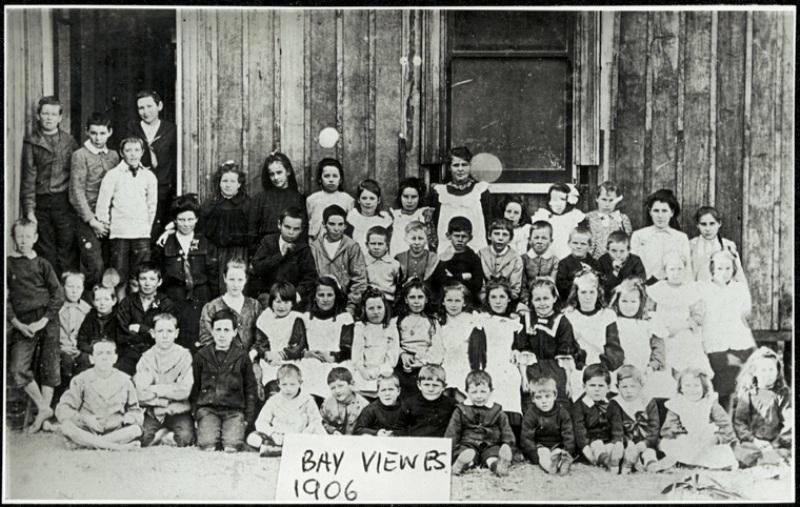
Bay View PS students 1906, Image No.: 15051_a047_000882, courtesy State Records NSW
Transfers and Appointments - Teachers: Mr. S. Morrison, from Newport to Mona Vale;SCHOOLS AND SCHOOL TEACHERS. (1906, September 5). The Sydney Mail and New South Wales Advertiser (NSW : 1871 - 1912), , p. 626. Retrieved fromhttp://nla.gov.au/nla.news-article163682045
Mr. S. Morrison, who for 22 years has keen in charge of the Bayview Public School, but who on the closing of the school was promoted to the new school recently established at Mona Vale, was presented on Wednesday with a handsome marble timepiece in appreciation of his services, and In recognition of his Interest in the pupils. The presentation was made by an old pupil, Mr. W. Austin. Mrs. Morrison was presented with a silver mounted hall set. PERSONAL. (1906, November 27). The Sydney Morning Herald (NSW : 1842 - 1954), , p. 6. Retrieved from http://nla.gov.au/nla.news-article14807260

Above and Below: Panorama of Mona Vale, New South Wales, ca. 1930 [picture] / EB Studios National Library of Australia PIC P865/125 circa between 1917 and 1946] and sections from made larger to show detail. See: Pittwater Reserves - The Green Ways: Mona Vale's Village Greens a Map of the Historic Crown Lands Ethos Realised in The Village, Kitchener and Beeby Parks
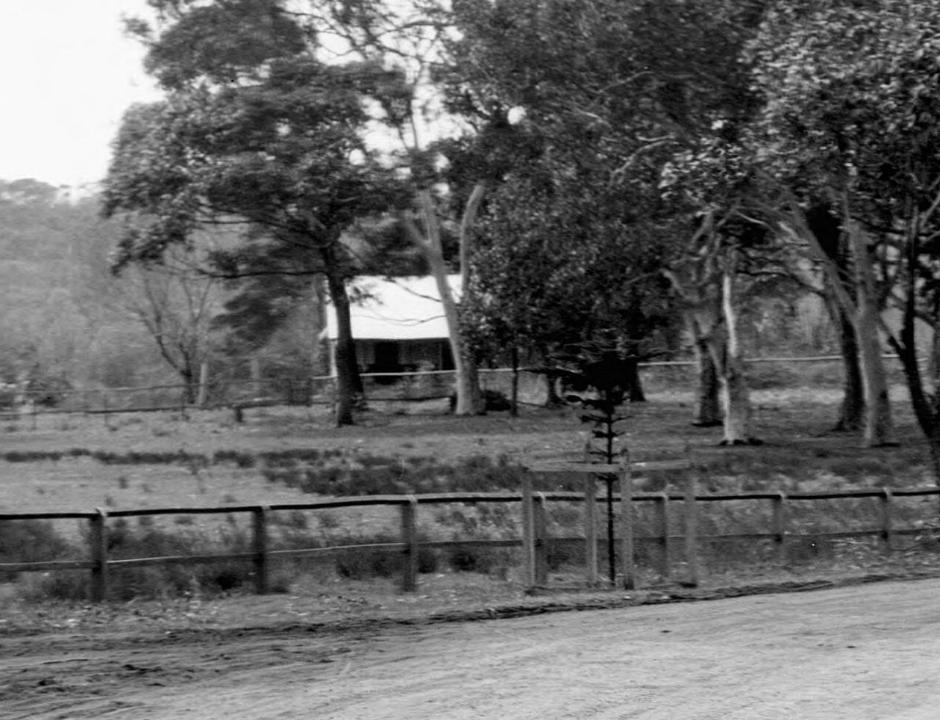
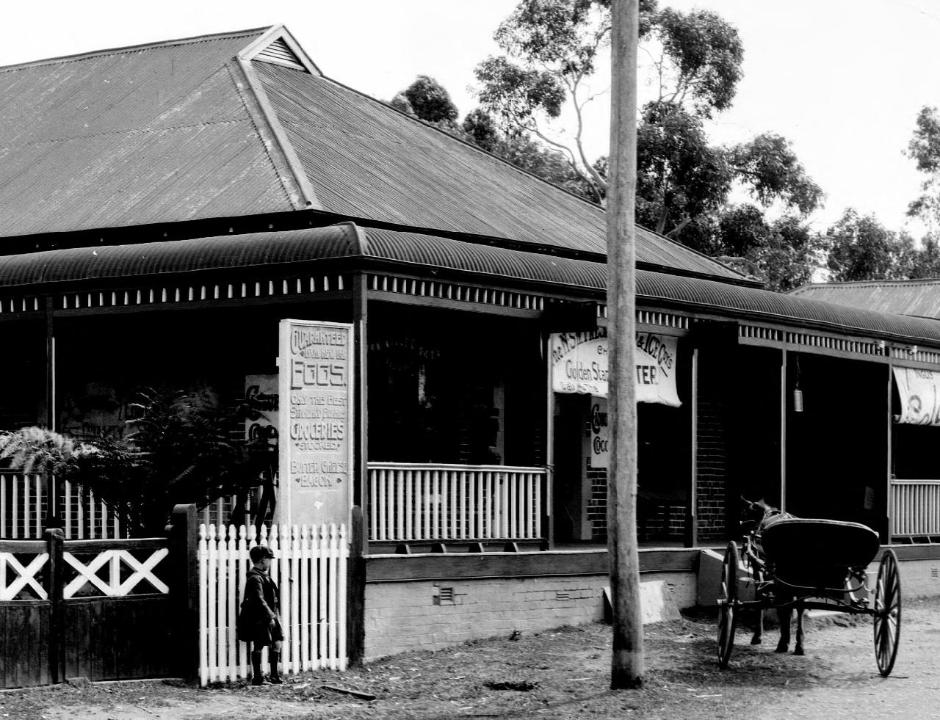

In January 1907 the school premises is offered for sale:
Under Instructions from the Minister of Public Instruction, the Hon. O’Conor, M.L.A. Block of land, situate Pittwater, in area 1 acre and 15 ¼ perches, between Bay View Post Office and Church Point, facing the Main Road, with frontage thereto of about 165ft, by depth of about 332ft, on which are two buildings, formerly occupied as (1) the Public School, (2) the Head Master’s residence – both buildings are substantial, and in good repair.
Batt, Rodd, and Purves, Ltd., are instructed by the Hon. The Minister, to submit to public auction, at their rooms 88 Pitt Street, on Tuesday, the 5th February, at 11.30 a.m., The Residence and School Buildings, situate at Bay View, Pittwater, owing to a new school having been established on a site more suitable to the requirements of this district. Advertising (1907, January 19). The Sydney Morning Herald(NSW : 1842 - 1954), , p. 22. Retrieved from http://nla.gov.au/nla.news-article28156238
WITH THE CHILDREN. HOMEWARD BOUND.
Some few years ago in and around Pittwater were found many children who could neither write nor spell their own names. The nearest school was miles away, and quite inaccessible to the children living at-the mouth of the bay. Directly the attention of the department was called to this matter it set itself to remedy so great an evil. A trim little-oil launch was requisitioned, subsidised by the Government, and now the visitor to Newport, Bayview, Clareville, or Kurring-gai Chase', may see the unique spectacle of a launch full of children going- to or from the public school at Church Point.
It starts on its way at 7,15 a.m., and gathers the children from tho many little bays and inlets that make beautiful that fine stretch of water to the left of Barrenjoey. At 9.30 tho pupils are all seated .at their desks.
Afternoon is the best time for the visitor to take a trip with the launchman, and see how the State caters for the children.
The launch leaves Newport on the home-ward journey about 3.15 p.m. It heads straight for the point, where the children, some 25 or 30 of them, having left the pretty schoolhouse half a mile distant, have assembled themselves on the jetty. A pretty picture they make, too, as they stand on the steps, white-pinafored, 'dark coated,' rosy-checked, with bag in hand or slung over shoulder. The launch draws alongside. The bigger boys and girls step in, carefully watched by the assistant, who lifts the smaller ones and sets them quickly but gently on the deck of the boat. Another moment and-away she goes with her cargo of little souls. A quick steam along the right shore, and a stop is made at one of the pretty bays for which Pittwater is renowned. A curly-headed little girl, some 6 years old, and her bigger brother are landed. They shout a merry "Good-bye" to tho other youngsters, and off they go to the big house, where their parents are. Another stop, and three others are landed, along with sundry loaves of bread, and what looks uncommonly like a leg of mutton. Further on a halt is made to deliver the day's paper, a tin of biscuits, three loaves of bread, and two more children.
The launch is slowing down. This landing is not so easy as the last. There is no wharf here. The fisherman pulls out in his boat, draws alongside, and the children step in. A few loaves of broad, a letter, and sundry parcels accompany them.
Many stoppages are made before Barrenjoey is reached. The largest number of children are delivered to here, along with a larger, supply of provisions.
It is said that boys and girls of 1-7 living in this lonely, out-of-the-way place had no means of education until, the department provided this means of conveyance, and carried them free of charge to the school at the head of the bay. The launch turns homeward, but it is a long run before the four remaining children are landed.
It grows colder ; They huddle closer together. The launchman suggests a song. Their willingness to comply proves it to be the usual way they pass the time down the bay after losing their companions. Four shrill little voices pipe "When the Empire Calls," "Three' Blind Mice," and "The Canadian Boat Song." "God, Save the King" gives the visitors timely warning that they are nearing home, though there is no sight or sound of habitation. They are landed at last. Their day is a long one. They are the first passengers and the last. They must make an early start, for their home lies three-quarters of a mile from the water. Away they go, each carrying a loaf of broad and their schoolbags. They are a wee bit timid of the walk just yet. An evening or two previous they were in sight of home when two native cats jumped down on the narrow bush track. With one accord they dropped everything, turned themselves round, and never stopped running till they reached the water where 15 minutes previously they had been landed.
A quick run of half an hour with one or two stoppages for the delivery of provisions to the lonely fisherman or selector brings the launch back to its moorings.
Truly we live in wondrous times when the education of the children of the solitary fisherman, the lighthouse keeper, or the caretaker is thought of so much importance that means are found to bring them to the in to whom that education can be obtained.-"Herald." ZAVA.
WITH THE CHILDREN. (1906, December 25). Clarence and Richmond Examiner (Grafton, NSW : 1889 - 1915), p. 2. Retrieved from http://nla.gov.au/nla.news-article61461790
PITTWATER SCHOOL CHILDREN. DEPUTATION TO MR. HOGUE.
The Minister for Education, Mr. Hogue, was yesterday called upon by a deputation who asked that the department should grant a subsidy of £3 10s a week to enable children living at Barranjoey, and other parts of Broken Bay to be conveyed by motor-launch to the Newport Public school. There had formerly been a school at Church Point, at the head of Pittwater, which had been abandoned on the understanding that a pate motor service to Newport would be supplied. Towards this service the department had allowed £2 10s' per week. But at that rate to maintain a service had been found impossible, and since Christmas 17 children had been without schooling. The service would cost at least £5 per week; but it the department gave £3 \10s the parents would guarantee the rest, and undertake all responsibility' But they asked to be allowed to choose their man. Thirty-two miles had to be covered, and a good sea-boat was needed, and a, man well accustomed to motors. If the school, at Church Point were established a conveyance would still be needed for the light-house-keeper's children.
Messrs. F. W. J. Donovan, J. Williams, jun., and E. J. Miles spoke to the above effect. Mr. Hogue said the case was exceptional, and entitled to consideration. The increased allowance they asked would mean a very considerable addition to the expense undertaken. But It was hard that those the deputation represented should be deprived of the benefits of schooling for their children. He would look into the matter, and see what could be done. PITTWATER SCHOOL CHILDREN. (1909, April 1). The Sydney Morning Herald (NSW : 1842 - 1954), , p. 11. Retrieved from http://nla.gov.au/nla.news-article15047452
Mr Morrison continued teaching, finishing his career at Newport Public School:
Teachers' Meeting
A meeting of teachers was held at the Adelong Superior Public School on Saturday last, Mr. Barnes presiding. The chairman extended a welcome to Mr. Moody, the new headmaster of the school and Mr. Moody suitably responded. It was decided to cooperate in the matter of a Teachers Journal. Mr. Moody was elected President of the Association, in place of Mr. Clarke, resigned. Proposed to ask Mr. Morrison, Public School, Newport, to represent the Adelong branch at the Conference of the Country Branches Association, to be held at Michaelmas. Teachers' Meeting. (1919, September 11).The Tumut and Adelong Times (NSW : 1864 - 1867; 1899 - 1950), p. 4. Retrieved from http://nla.gov.au/nla.news-article139039116
Mr. Sam Morrison of Newport school enters on 11 months long leave on October 10, prior to retirement. He began as teacher at Pittwater in 1884 and was transferred to Mona Vale 1886, Freshwater 1912, Newport 1918. EDUCATION. (1922, September 30).Tweed Daily(Murwillumbah, NSW : 1914 - 1949), , p. 2. Retrieved from http://nla.gov.au/nla.news-article193480838
Mr. Samuel Morrison, Teacher, Public School, Newport. Last day of service, 6th October, 1923. RETIREMENTS. (1922, September 8).Government Gazette of the State of New South Wales (Sydney, NSW : 1901 - 2001), , p. 5075. Retrieved fromhttp://nla.gov.au/nla.news-article222059868
SUPERANNUATION AMENDMENT ACT, No. 44, 1918.
PROCLAMATION. (l.s.)
PHILIP GAME, Governor.
Sir Philip Woolcott Game, the Governor of the State of New South Wales, in the Commonwealth of Australia, with the advice of the Executive Council, and in pursuance of the provisions of section 3 of the Superannuation Amendment Act, No. 44, 1938, do by this my Proclamation declare that the following seventeen persons are entitled to receive payment of the Superannuation allowance due to them respectively during the periods which they have been or may be employed in the supervision of candidates for the, Examinations conducted by-the Department of Public Instruction:— Morrison, Samuel. SUPERANNUATION AMENDMENT ACT, No. 44, 1918. (1932, April 22). Government Gazette of the State of New South Wales (Sydney, NSW : 1901 - 2001), , p. 1347. Retrieved from http://nla.gov.au/nla.news-article219910907
Samuel Morrison passes away after 14 years of retirement:
11239/1936 MORRISON SAMUEL SAMUEL SARAH MANLY
MORRISON. - June 19, 1936, at his residence, Lecona, 39 Smith-st, Manly, Samuel, dearly beloved husband of Emma, and dear father of Ethel (Mrs. Bishop), Fred, Lillian (Mrs. C. Brede), and Percy. Privately cremated June 20, 1936. Family Notices (1936, June 22). The Sydney Morning Herald (NSW : 1842 - 1954), , p. 8. Retrieved from http://nla.gov.au/nla.news-article17244606
Bayview and Church Point having a school had a hiatus of just over three decades until 1947 when a school, known then and now as the Loquat Valley school, opened fairly simply, with a handful of children, around the corner from the school at Bay View, which, of course, was around the corner from the original school at Church Point. This was the inspiration of Sir Patrick Gordon Taylor - in Rick Searle’s new book ‘The Man Who Saved Smithy’ - released in 2015, papers researched by Mr. Searle cite on of the reasos for 'Bill' opening this school;
"Education should be purposeful, with direct personal results for the child from the work done.
The 'mental exercise' type of study is frustrating and is actually harmful because it encourages the child o accept the process of the work without practical results. It conditions the mind of the child to accept work which is distasteful, in afterlife, and to become merely a cog in the machine of human industry instead of forming the habit of constructive thought and personal effort.'
If the child is bored and inattentive and won;t work it is the fault of the teacher or the education system, not the child; for no human at any age is so inquisitive and so anxious to learn, as a child...
Children persistently search for knowledge but for knowledge that has a direct bearing on their lives,..
A child who refuses to devote time and effort to useless and unproductive study is more likely to succeed in life than one who studies merely of the sake of study. The former gets results. The latter goes on performing an exercise and nearly always becomes the victim of some dreary occupation. "
"The conditioning of humans to the slave life is a subconscious objective of the 'mental exercise' type of education. It reduces the free thinking child to a resigned, frustrated acceptance of circumstances.
The personal, practical result-based education will produce an active, positive human being, a strong nation, and a better world." Pages 302- 303 - From Taylor- Frigate Bird, published by Angus and Robertson 1953
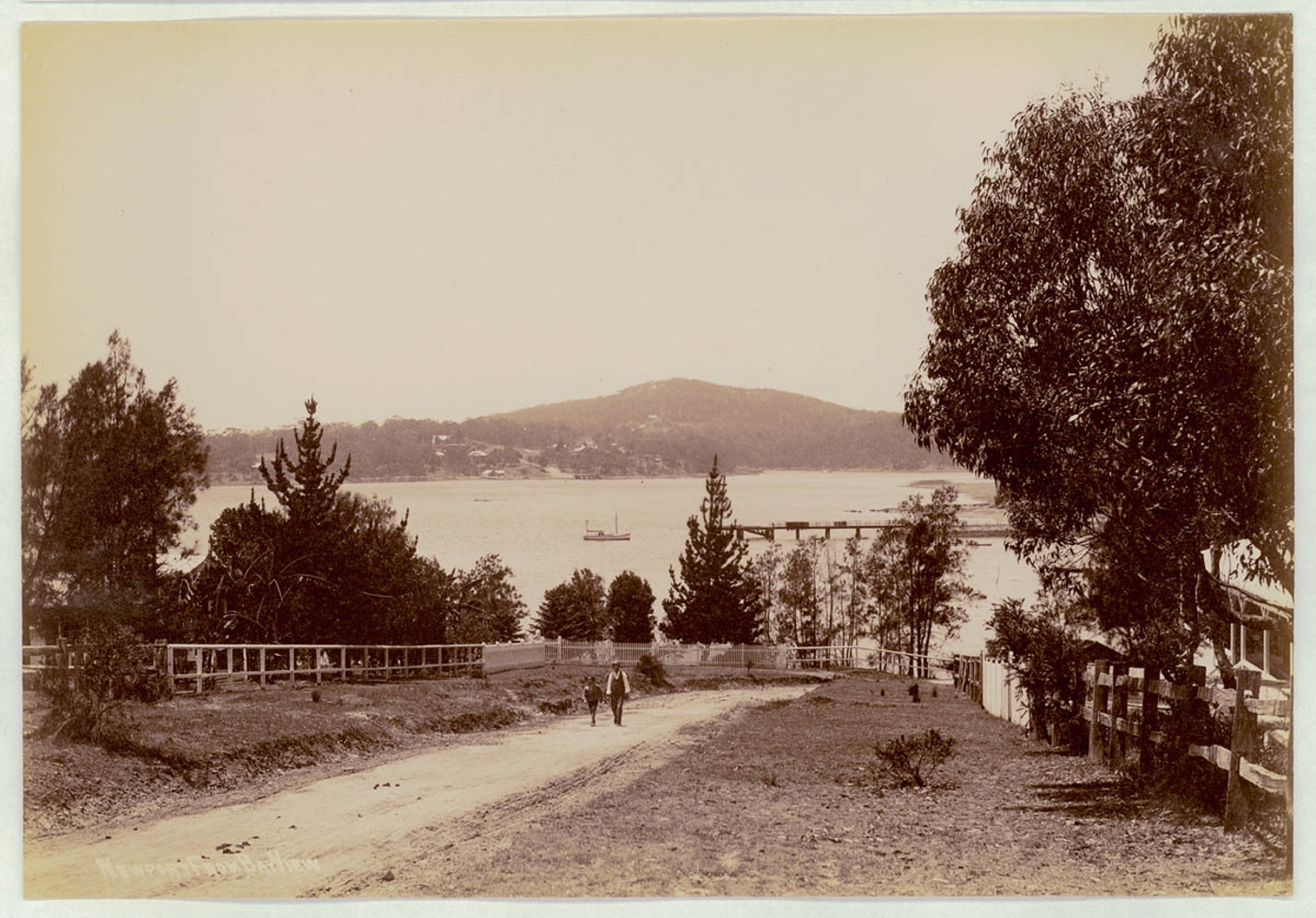
The Taylor house is behind pines at left. 'Newport from Bayview', ca. 1900-1910, Image No.: a116491, courtesy State Library of NSW.
There were also some other personal, results based reasons for opening a school so near his home, as listed in this article:
Airman Started A New Kind Of School
In a little bush clearing overlooking the reaches of Pittwater, 60 children are going to Australia's most unusual school-founded by an airman. Captain Patrick Gordon Taylor, pioneer of world air routes, set out after the war to blaze a new trail-and it led to Loquat Valley School, Bayview. He came home from service on the North Atlantic air routes with two daughters, Jennie (now 9) and Sue (7), and found there was no school for them to go to up that way. Others in neighbouring districts were full.
Captain Taylor decided to found his own school and neighbours welcomed the idea.
Captain Taylor arranged to start in a tennis club building, but the club found it needed its building. So 13 children attended their first session on the verandah of a nearby home.
From the old Army camp in French's Forest Captain Taylor bought two big huts.
Captain Taylor got the bricks by driving around the country in his car, telling his story to sympathetic but unhelpful brick-yard men. At last, one said: "You shall have the bricks to-morrow."
He got the bricklayer by persuading his household maid to talk her boy friend, a brick-layer on another job, into it.
Captain Taylor and his wife, his secretary and his school staff sawed wood, painted walls, made window boxes, helped with the building-and got the school going.
Now there are two full-time teachers at the school-Miss Joyce Kennington, who started the school in 1946 With Mrs. Gomme, and Mrs. John Day, who teaches the older children.
Right from the start Captain Taylor determined it should be an Australian school for young Australians to give them a feeling of confidence in their country and themselves, and to break away from ideas unsuitable to life in Australia.
He poured more than £5,000 into his ideal.
Children aged 3 to 11 sit at desks built of Australian wood, in airy classrooms with walls tinted in warm shades and ceil-ings a pastel blue.
BUSH RAMBLES
The children see their lessons chalked on a green board-not black, because it is too drab-1 and on their bush rambles they learn nature lore from seeing koalas and wallabies and possums and jet black rabbits frolicking in the undergrowth.
They swim in Pittwater, they ride ponies, they learn ballet.
Captain Taylor watches the school grow and plans how he will extend it-a swimming pool here, a new building there. And because it is an ideal he is working for, he puts back into it all the profits from fees.
BELOW: Children leave Loquat Valley School, Bayview, after their day's lessons. Airman Started A New Kind Of School (1949, November 20). The Sunday Herald (Sydney, NSW : 1949 - 1953), , p. 6. Retrieved from http://nla.gov.au/nla.news-article28665905
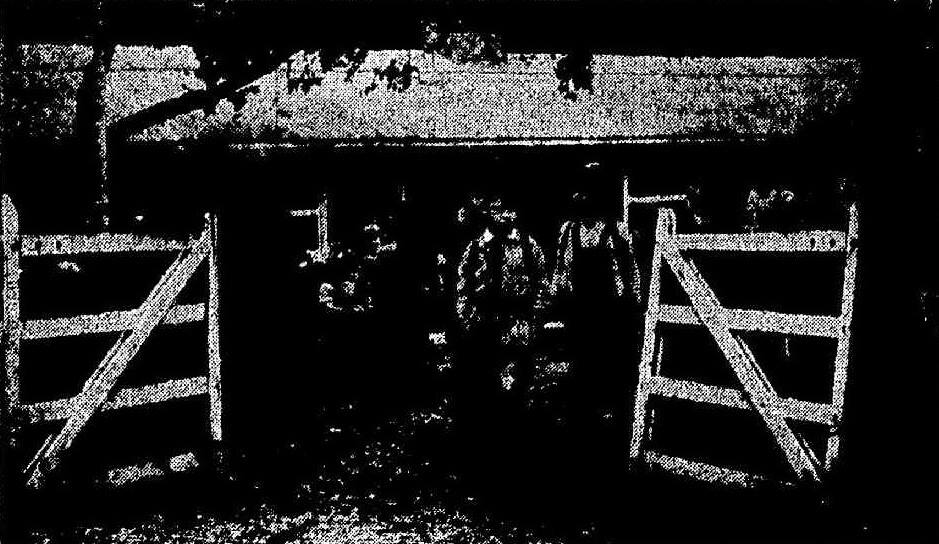
References
1.THE SCHOOLS at Church Point. Peter Altona and Sue Gould. 2012. Church Point History - Places, People & Activities - series of Historical Articles, Retrieved from: https://pittwaterhistory.files.wordpress.com/2012/08/120502-the-schools.pdf
2. SAMUEL MORRISON-Teacher. Peter Altona and Sue Gould. 2012. Church Point History - Places, People & Activities - series of Historical Articles, Retrieved from: https://pittwaterhistory.files.wordpress.com/2012/08/120428-morrison.pdf
JSN Wheeler, "Early Days of Bayview and Church Point" Journal of Royal Australian Historical Society, Vol.26, 1941.
Extras
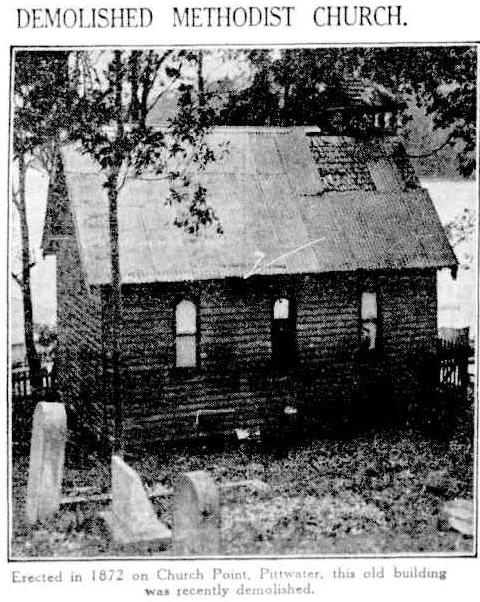
Church Point. The same year, a probationer in his third year, the Rev. Edward J. Rodd was beginning his two years' term at St. Leonard. His circuit extended to Pittwater, and that year the Church Point Church was erected at a cost of £60. The erection of the church was accomplished through the efforts of Messrs. Geo. McIntosh and Wm. Henry McKeown, who conducted services at Bayview under a tree. Mr. William Oliver gave the site. In many early records it is spoken of as Chapel Point Church. For several years it was used as a public school, and Sir Henry Parkes' signature appears in the old visitor's book. Where is that book now? Diamond Jubilee. (1932, December 17). The Methodist(Sydney, NSW : 1892 - 1954), p. 16. Retrieved from http://nla.gov.au/nla.news-article155292368
AT CHURCH POINT
On the precipitous slopes of the hillside overlooking the quiet backwater of Pittwater, and shaded by the silver coated gums, stands the little wooden church that gave Church Point its name. It is a quaint little structure in which a service is held occasionally, and I should think that ten people would crowd It. It has a tower bell. It looked up at the church from the road that winds round the waterside, and 'Johnnie' Roche, the man they call the 'Prince of Pittwater’— -who was my companion, asked me If I had seen the church yard. We scrambled up past the church, and then, among the rank grass and ever-spreading scrub, found the stones that mark the dust of the 'Rude forefathers of the hamlet.' Beside one weatherworn stones 'Johnnie' paused, and spoke to himself rather than to me. 'He was a relative of the teacher at the little school we got a holiday, I remember, to attend this funeral.' In this quiet spot rest many that were friends of my companion in his boyhood. The muter gardeners Time and Mature are gradually repairing this small 'God's Acre,' and the few graves are being gradually lost to human ken. Meanwhile the waters of the Bay lap the sand-fringed road, and motor parties Indicate that to-day is the day of the quick. The dead are of the past. Church Point. AT CHURCH POINT. (1922, November 23). Evening News(Sydney, NSW : 1869 - 1931), p. 8. Retrieved from http://nla.gov.au/nla.news-article118825051
Above right: DEMOLISHED METHODIST CHURCH. Erected in 1872 on Church Point, Pittwater, this old building was recently demolished. DEMOLISHED METHODIST CHURCH. (1932, April 7). The Sydney Morning Herald (NSW : 1842 - 1954), p. 12. Retrieved from http://nla.gov.au/nla.news-article16853823
WARHURST — CANNAN. — October 1, at St. Mary's, Mortlake, by the Rev. Canon Moreton, William Henry Warhurst, only son of Ralph Warhurst, of Mossleys, Manchester, England, to Matilda Cannan, eldest daughter of Henry Dexter Cannan, of Lockleys, Concord. Family Notices (1888, November 27). The Sydney Morning Herald (NSW : 1842 - 1954), , p. 1. Retrieved from http://nla.gov.au/nla.news-article13704960
Henry Dexter Cannan 9 acres 2 roods 12 perches on Mortlake Street & Brays Road in Town & Parish Concord County Cumberland – State Records of NSW 01/01/1863 to 27/01/1892 Volume 1042 Folio 97
BRINCK-CANNAN.-February 27, 1800, at Christ Church, Sydney, by the Rev. C. F. Garnsey, Gustavus Adolph Brinck, the third son of Johan Brinck, of Sweden, to Emily Anne Cannan, second daughter of Henry Dexter Cannan, of Lockleys, Concord. Family Notices (1890, February 28). The Sydney Morning Herald (NSW : 1842 - 1954), , p. 1. Retrieved from http://nla.gov.au/nla.news-article13761297
Mr. Henry Dexter Cannan, to be third clerk and messenger in the Lunacy Department, to take effect from 1st ultimo. GOVERNMENT GAZETTE. (1879, August 23). The Sydney Morning Herald (NSW : 1842 - 1954), , p. 3. Retrieved from http://nla.gov.au/nla.news-article28390093
Chief Secretary's Office,
Sydney, 9th August, 1900.
HIS Excellency the Governor, with the advice of the Executive Council, and upon the recommendation of the Public Service Board, has approved of Mr. Henry Dexter Cannan, Clerk, Master in Lunacy's Office, being permitted to retire from the Public Service. JOHN SEE. Government Gazette Appointments and Employment (1900, August 17). New South Wales Government Gazette (Sydney, NSW : 1832 - 1900), , p. 6422. Retrieved from http://nla.gov.au/nla.news-article222758647
Did Mr. Morrison conduct classes at night too?:
ESTABLISHMENT OF PUBLIC SCHOOLS.-In Kegworth, near Summer-hill ; in Cobar (evening) ; evening schools in Blackfriars, Pittwater, and Redfern. Government Gazette. FRIDAY, AUGUST 1[?]. (1886, August 21). Australian Town and Country Journal (Sydney, NSW : 1870 - 1907), , p. 17. Retrieved from http://nla.gov.au/nla.news-article71066479
It was not a matter of surprise when it was announced that Mr. W.H. McKeown had passed away on Sunday morning last. He had attained the goodly age of 91 years, and was gathered at last as a shock of corn fully ripe. He was a real father in our Methodist Israel, and his story deserves to be more fully told. He was buried on Tuesday last in the Waverley Cemetery. For the present we content ourselves with a journalist's tribute as it appeared in the 'Daily Telegraph' of Tuesday, June 11th.
THE PASSING OF A PIONEER. In the death of Mr. William Henry McKeown, sen., there has passed away one of the oldest colonists of the State, and one of the pioneers of the North Sydney district. His reminiscences of the early days in
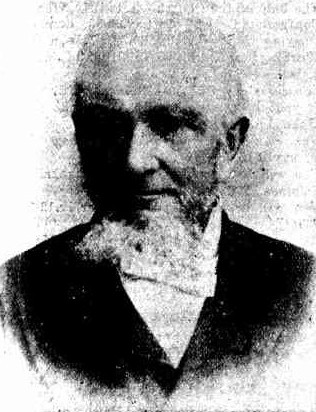 THE LATE MR. W. H. McKEOWN. [photo]
THE LATE MR. W. H. McKEOWN. [photo]
what was then called the Lane Cove district were always interesting, and the contribution he made to the material and moral welfare of the neighbourhood such as to deserve honourable mention. Mr. McKeown arrived in Sydney early in the year 1840, being then a lad of 19 years of age. He came from Ireland, and brought with him the sturdy qualities of the typical North of Ireland stock. His early attempts at finding a footing in Australia were associated with the care of 'Government men,' an employment from which he shrank, and which he speedily gave up. One temporary job succeeded another, in which his self-reliance and power of adaptation were tested and developed. About the year 1845 he accepted an engagement in connection with a newly-planted orangery in what is now called Pymble, and thither, with his young wife, he removed. Crossing from Sydney to the northside of the harbour, he found there was no made road to what was then the distant bush. He had to find his way through a dense forest, simply following dray tracks through the bush. A few bark huts at intervals along the way, the abodes of sawyers and wood getters, were the only signs of occupation of the territory where now stand the thriving suburbs of North Sydney, Chatswood, Roseville, Lindfield, and Gordon. Arrived at Pymble, there was a house licensed to sell beer only, an old wooden church, which served also as a school, and a public-house, where all sorts of drink, were sold. A gang or two of 'Government men' were employed hereabout, and timber-getting as the principal occupation. Orcharding on a small scale was also being attempted. For over half a century Mr. McKeown lived in the district, and witnessed its emergence from the primitive conditions in which he found it to one of the most popular and thriving of all the environs of the city of Sydney. The record of his personal struggles interesting enough to form the subject of a popular autobiography. The path of the early settler was beset with many difficulties. Droughts were interspersed with terrific hailstorms, the latter of which occasionally stripped the orchards and rendered them comparatively unproductive for years. Labour troubles even then in evidence although unions and strikes had not been invented. The discovery of gold caused a stampede to the west of the Blue Mountains, labourers, clerks, shop-keepers, and even lawyers forsook their wonted employ to find their El Dorado at the Turon and Tambaroora. Mr. McKeown sufficiently caught the fever to take two trips across the mountains, but it was rather as a chartered driver in charge of organised parties, under contract for a consideration, than as a gold-seeker on his own account. He never believed in sudden roads to wealth, and never found one for himself. From the first Mr. McKeown was interested in the religious welfare of the district, and laboured personally earnestly to promote it. An old stone building stands on the Gordon-road, in Gordon, now as a store, which was the first substantial edifice for public worship erected north of North Sydney. It was built in the early fifties, at a cost of £850, and served also as a schoolroom, with master's quarters attached. For many years this was known as "Lane Cove" Chapel, and was served by ministers from the York-street Methodist Church, and by local preachers, of whom Mr. McKeown soon became one. The debt on it fell principally on its promoter's shoulders, and quaint are the tales he used to tell of the devices resorted to to meet the interest and reduce the debt. Zeal and self-denial eventually overcame all difficulties. 'Revivals' were frequent, and delighted the heart of the earnest man who was set upon the spiritual welfare of his neighbours. As population increased and spread, other 'chapels' were built at Willoughby, Hornsby, Pittwater, and other places, these being the pioneer places of worship in their respective neighbourhoods. As long as strength lasted Mr. McKeown continued his voluntary labours as a lay preacher, and at the time of his death he was probably the oldest local preacher in Methodism in Australia. Apart from his special interest in Church matters, Mr. McKeown was a good citizen in respect of the interest lie took in the social and material welfare of the district. He introduced new and improved methods of fruit culture. As a poultry-raiser he showed what could be done by special strains adapted for egg-production or for table use. He set a high standard of commercial morality, and when on one occasion he assigned his estate — mainly through the failure of others to meet their engagements to him — he subsequently paid most of his creditors in full, although under no legal obligation to do so. He was an ardent politician, and took a keen interest in public affairs right up to the last. In the, days when candidates were openly nominated on nomination day, he was frequently chosen to 'propose' a candidate from the hustings, and. his local influence was such that his candidate usually topped the poll. For a period he served as an alderman in the City Council, when he was carrying on business as a wood and coal and fruit merchant in Sydney. More than once he was asked to stand for' Parliament, but he could never be persuaded to become a candidate. His house was ever a 'centre' of kindly hospitality, and the record of those who have sat at his table or slept under his roof at Roseville, Pymble, where he resided for over half a century, would be interesting as including ecclesiastics of all Churches, politicians of all hues, and commercial men from all the States and from over the seas. Since 1880 the North Sydney district has witnessed a wonderful development, and has become one of the most popular of all the residential areas of the metropolis. The Milson's Point-Hornsby railway line, has been the principal factor in bringing this about, and in securing the construction of the line Mr. McKeown took a leading part. Public meetings and deputations were organised by him, in conjunction with a few others, and successive Ministries were importuned until the work was put in hand, and at length carried to completion by the extension right to Milson's Point. With this the veteran's public work seemed to come to an end, and shortly after attaining his80th year he removed from the scene of his half century's labour to reside in quietude at Summer-hill. On leaving, he was made the recipient of several demonstrations evincing the esteem and appreciation entertained for him and his wife (who survives him)by the residents among whom they had lived so long and usefully. A family of 10 children and between 50 and 60 grandchildren, with several great-grandchildren, is the best legacy the venerable pioneer has left to the State. His sons are Rev. R. McKeown, of Waverley; Mr. G. M. McKeown, of Wagga Wagga Experiment Farm; Mr. J. McKeown, of the Civil Ambulance Corps; Mr. W. H. McKeown, of Ashfield; and Mr. E. McKeown, of Belford. His sons-in-law are Rev. G.M'Intosh, of Chatswood; Mr. J. G. Edwards, of Kil-ara; Mr. W. Benson, of Waverley; Rev. J. E. Carruthers of Lindfield; and Mr. H. Hazlett, of Summer-hill. THE LATE W.H. McKEOWN. (1912, June 15). The Methodist(Sydney, NSW : 1892 - 1954), p. 3. Retrieved from http://nla.gov.au/nla.news-article155458683
Chave Family Notes
The Royal Alfred paddle steamer has been purchased from the Port Jackson Steam Co, by Mr. Halstead for £1500, and the ketch, Maid of Australia, has been purchased by Mr. F. Chane, of Pittwater for £100. The Young Dick, steamer, has been purchased by Mr. F. Silva, of Watson’s Bay, from Mr. B. Wanning, for £1000. Along the wharves. (1885, February 17). Evening News(Sydney, NSW : 1869 - 1931), p. 4. Retrieved from http://nla.gov.au/nla.news-article111182893
The coaster Maid of Australia has been sold by Mr. G. Crestenoff to Mr. F. Chave, of Pittwater, for £100. IMPORTS.—FEBRUARY 14. (1885, February 17). The Sydney Morning Herald (NSW : 1842 - 1954), p. 6. Retrieved from http://nla.gov.au/nla.news-article28367085
APPLICATION, TO ERECT A BOATHOUSE, BATHINGHOUSE, and JETTY, on PILES.
Attention is invited to the notice in the Government Gazette of the 24th instant, calling for objections (if any) to the application of Messrs. Chave and M'Culloch; to erect a Boathouse, Bathinghouse, and Jetty, on piles, in front of their property at Pittwater, Parish of Broken Bay, County of Cumberland.
CHARLES OLIVER. Under-secretary. Department of Lands, Sydney, 8th February, 1885. Advertising. (1885, March 14). The Sydney Morning Herald(NSW : 1842 - 1954), p. 5. Retrieved from http://nla.gov.au/nla.news-article28365891
PITTWATER, opposite SCOTLAND ISLAND.
30 ACRES OF GOOD ARABLE LAND, portion planted with about 700 Fruit Trees, AT PITTWATER, with W.B. COTTAGE, containing 6 rooms and outhouses thereon. This property, which was formerly known as Chave's, is immediately opposite SCOTLAND ISLAND.
HARDIE and GORMAN have received instructions to sell by public auction, in the ROOMS, 133, PITT STREET, THIS DAY, 12th OCTOBER. the above-described ORCHARD PROPERTY at PITT-WATER, surrounded by the improved properties of Messrs. Willens, Wood, S. B. Bailey, Dr. Tibbitts, and others. The attention of tho public generally is particularly directed to the Sale as offering great PROSPECTIVE ADVANTAGES, for besides the income to be derived from the cultivation of the land, the proposed RAILWAY to PITTWATER (the bill for which is now before Parliament) is surveyed close to the property, and must, If carried out, Immensely enhance the value. Advertising (1887, October 12). The Sydney Morning Herald (NSW : 1842 - 1954), , p. 15. Retrieved from http://nla.gov.au/nla.news-article13674341
CHAVE—COX.May 22, at St Paul's, Carlingford, by the Rev. George M'Intosh, Arthur Bede, eldest son of Frederick Chave, Carlton Villa, Pitt Water, to Ada Mary, eldest daughter of William Cox, Honiton, Carlingford. Family Notices (1889, June 22). The Sydney Morning Herald (NSW : 1842 - 1954), , p. 1. Retrieved from http://nla.gov.au/nla.news-article13738996
CHAVE—MAPPIN. —February 8, at the residence of the
bride, No. 2 Carlton-terrace, Hereford-street, Forest Lodge, by the Rev. J. Bennett Anderson, Frederick William, second son of Frederick Chave, Esq., Brighton Villa, Pittwater, to Henrietta Blanche, fifth daughter of William A. P. Mappin, of Middlesex, England.Family Notices. (1894, March 3). The Sydney Morning Herald(NSW : 1842 - 1954), p. 1. Retrieved from http://nla.gov.au/nla.news-article13942629
CHAVE. — August 3, at his residence, Pittwater, Frederick Chave, aged 66 years. Burial to-day, Thursday, 3 p.m., at Church Point. Family Notices. (1898, August 4). The Sydney Morning Herald(NSW : 1842 - 1954), p. 1. Retrieved fromhttp://nla.gov.au/nla.news-article14130030
DEATH Of A PIONEER COWRA. Wednesday
Mrs. Elizabeth Chave has died at the age of 92. Her husband, the late. Mr Frederick Chave travelled by bullock dray from Parramatta to Warren where he acquired Dungaleer Station. Some years later he returned to Sydney and settled at Pittwater. At onetime Mr Chave owned Kuring-gai Chase. Mrs. Chave is survived by ten children, 25 grandchildren, and ten great-grand-children. DEATH OF A PIONEER. (1934, August 2). The Sydney Morning Herald (NSW : 1842 - 1954), p. 10. Retrieved from http://nla.gov.au/nla.news-article17095056
Morrisons own Premises they rent out at Bayview
These premises were originally purchased by Mr. Morrison's wife soon after her father passed away:
“One of the agencies that helped to make this district better known was the introduction of the furnished cottages. Mr F. Chave had one on the Ku-ring-gai Chase side. I had two on the Bayview side, near Fig Tree Flat, named Killarney and Drumtochly. … Mr Ireland had another furnished cottage near Church Point. Each of these furnished cottages were supplied with a good pulling boat and had enclosed baths.” - Samuel Morrison 1929.
"The Morrisons have two furnished cottages at Bayview that they advertise and offer as summer resorts. These two cottages Drumtochty and Killarney, situated on Bay View Road, are east of the school premises and the Morrisons’ residence. *Drumtochty is situated some 75 feet east of *Killarney cottage, on the property boundary.
" At the waterfront of the bay where Killarney and Drumtochty are situated is Figtree Flat, also known as Cape’s Flat. This flat with its greensward is a favourite picnic ground." - J.S.N. Wheeler
*Drumtochty is the name of a castle and forest in Scotland. The Killarney Lakes are found in Ireland.
1899 “Bayview – Killarney and Drumtochty, furn., water frontage, wood, boat, linen. S.Morrison, Bayview. Sydney Morning Herald, 16 October 1899 P.10.
“To Let Bayview, Killarney, and Drumtochty, furn., linen, wood, boat, wat. F., bathing, &c. Morrison, Bayview.” Sydney Morning Herald, 11 November 1899 P.15
1900 “Bayview Pittwater Furn Cottages, 4 bedrooms from …., boat firewood, water. S. Morrison, P.O.“ Sydney Morning Herald, 6 October 1900 P.15
1901 “Summer Resorts - Bayview – Furn. Cottages ev. conv., good fishing, bathing, boat. Term S. Morrison Bayview P.O.” Sydney Morning Herald, 16 March 1901 P.6
The Rainaud's (Henri and Hedwig) set up a fine restaurant and accommodation at Bay View, Hedwig eventually buying the property from Emma in 1908 and calling it 'La Corniche' - this is the same couple that later on have a brief version of 'La Corniche' at Brock's Oaks Estate prior to moving to the Blue Mountains.
BAYVIEW -Furn Cot, 4 bedrms, boat, bath , fish., available for Easter. S Morrison, Bayview PO, BAYVIEW -Drumtochty and Ripley – First class Accom. French cuisine ev. home con. H Rainaud. Advertising (1906, March 24). The Sydney Morning Herald (NSW : 1842 - 1954), , p. 6. Retrieved from http://nla.gov.au/nla.news-article14761347
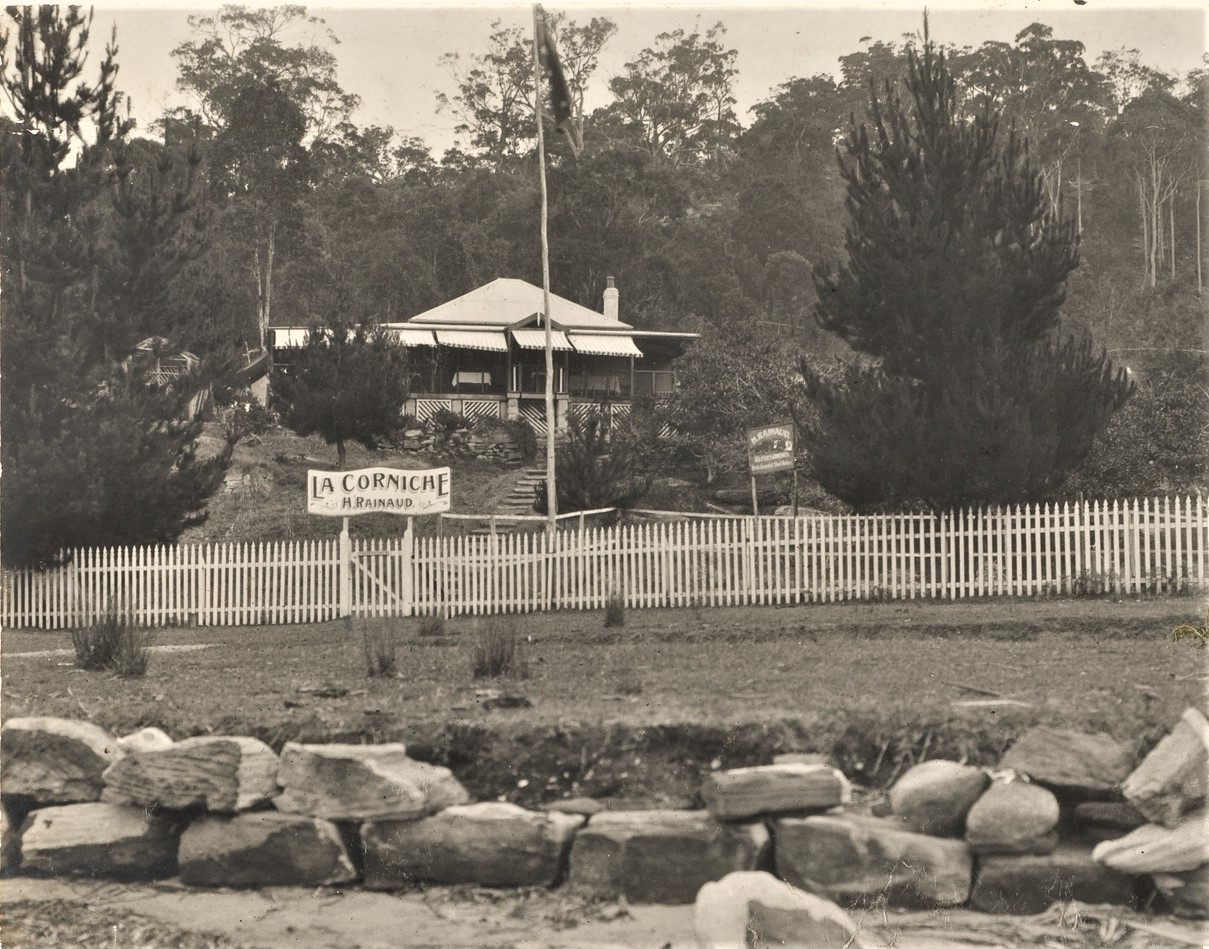
From The Mort Family Album, Image 131. H. Rainaud's restaurant La Corniche, Digital Order No. a1780131, from State Library of NSW - Visit: La Corniche, Bayview
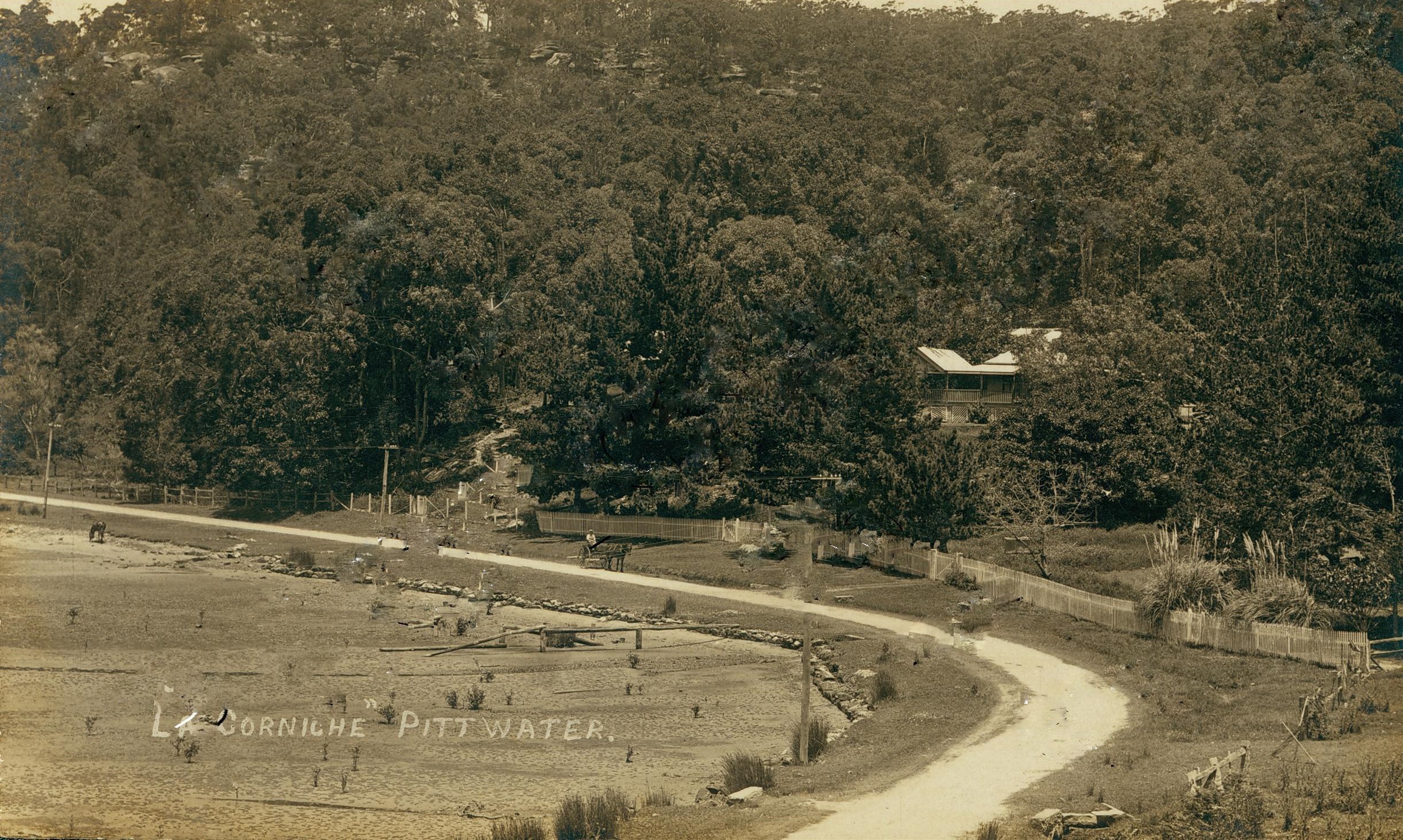
Fig Tree Flat La Corniche Bayview circa 1900 - 1910
Warriewood and Mona Vale Estates begin the necessity for a Public school at Mona Vale:
ON THE LAND. HOW TO GET A FIRST QUALITY BLOCK. LARGE CAP ITAL NOT NECESSARY. NO INSTALMENTS REQUIRED FOR TWO YEARS. NO IRRITATING GOVERNMENT ROUTINE. THE WARRIEWOOD FARM BLOCKS.
At a time like the present, when the above question is of absorbing- interest, the placing of such an Estate as Warriewood en the market must attract widespread interest, as it solves a great difficulty for those searching for land who do not possess a large amount of ready-money, and where not only can possession of the land be obtained without any delay, but the return of some profit is yielded from the land within a few months. The Warriewood Farms contain soil of an extremely high quality, suitable for the most approved and successful schemes of intense culture, therefore the farms range from about two acres, but a block of 100 acres can be made up if required. Official analyses of the soil by the New South Wales Department of Agriculture show it to be richer in fertilising ingredients than the famous Richmond River soil. All that is required from a Purchaser is a small deposit, only sufficient to show good faith, on payment of which he is given immediate possession, and when he either builds a small dwelling or fences and partly clears the land (to do either Dfwbich, a very ample amount of time is allowed), then he need not pay any purchase money for two years. If he has some money all- the better, and he can pay for the laud outright it' he likes, but if not, These liberal terms give him the opportunity not only of making a start, but firmly establishing himself before having to pay any instalments or have such like calls upon his resources; and when in two years these do begin, there can be no doubt but that the land itself will be so productive -that the small payments will not be noticed out of the income then derived from it. The 'actual 'experience 'of growers on the adjoining Estate — only a very small proportion of which equals Warriewood— shows that the land can be ' prepared- and a good return obtained easily within a year. Some have sold produce within 7 months. Mr. Duffy, with no labor but his own,' obtained £43 for peas from an acre and a quarter, which, less than a year, before, was bush land. Even then the land is available for one or two crops; of something else during the same year, according to what may be planted. The main requirement to obtain this result is health, and strength, for the expense outside labor is exceedingly small.
Another grower right on the Warriewood boundary has actually received £22 from almost a quarter of an acre of peas, and other crops have given exceedingly good returns. From this it must be clear that this land is something out of the common and well able to - support a man and his family; and it is certain the lenders could not offer such easy terms unless they felt certain of purchasers finding it to their advantage to remain on the land once they got there.
It may be added that the terms of payment extending in all over a period of ten years, while purchasers have the option of paying off the whole or any part at any time, and here, again, it may be said, that the Vendors in allowing so long a period, know full well the desire : of nearly all men to make their holdings free as soon as possible, and are certain the wonderful fertility of the land will enable them to do this in much under ten years if they care to do so. All the Farm Blocks are situated in a sheltered vale, intersected by the Narrabeen and Fern Creeks, being protected from the easterly and northerly winds by the Ridge on which the Hill Lots are situated, and from the westerlies and southerlies (.the worst winds) by a high range of rocky hills a short distance away from the Estate boundaries. The climate is so salubrious and the temperature so mild and even that all plants and flowers nourish with luxuriance, and come to maturity and bear some weeks earlier than in other districts around Sidney, with the consequent high prices always paid for early products of good quality. There is almost an entire absence of frost, as proof of which it may be stated that as many as three crops of potatoes have been obtained in one year from the same piece of land. The.- soil is a very rich black, deep, slightly Sandy loam of the land so prized by nurserymen, and easily worked. So rich is it that even in its virgin: uncultivated state the verdure is almost tropical, as can be seen by the natural Palm Groves, on the Estate. The subsoil is of a very porous nature for a considerable depth, affording natural drainage. The Estate being so handy to the City by a first-class road, growers can take their own produce to market, thereby saving all freight and agency charges, and getting the full benefit of prices obtained, without having to employ or trust any agent or dealer. At the same time all necessaries can be purchased at the best and cheapest City shops. Fine, timber, including iron bark, stringy bark, grey gum, turpentine, mahogany, forest oak, and others are available in plenty for building, fencing, firewood, and other purposes. The fine coastal rainfall here is ample for all requirements, and the excellent loamy soil possesses that grand characteristic of retaining the moisture for much longer than ever happens between rains the surface never cakes or bakes, so that even in what might be termed a dry season all vegetation continues to flourish and droughts as experienced in the country districts are quite unknown.
The Rocklily Estate, adjoining Warriewood, which was recently subdivided, giving the first opportunity for land to be secured in this district, was'- nearly all snapped up within an incredibly short space of time. Some parts of it adjoining Warriewood are good lots, but a large portion is inferior to Warriewood, which is all good. A large number of families are already settled on the Rocklily Estate, but now that Warriewood, with 70 Farms, in addition to the Township and the Hill Lots, is available, rapid progress is assured.
Even the development of the smaller Rocklily Estate caused the Public School to be removed from Bayview to hard by the Estate, and resulted in the Post-office being placed in a higher class. The powers that be have realised the possibilities of this hitherto locked-up but magnificent district, and nothing can now bar it from making rapid strides along the path of progress. The Estate was tested for water during the driest known season by a well sunk at random on one of the easy slopes well away from creeks, &c, and a plentiful supply of good fresh water obtained. It has been said with much truth that 5 acres here is better, easier, more satisfactory, and more profitable than 500 in the back country, and it affords as well all the advantages and occasional pleasures of the healthy suburban life so desirable for the proper rearing of a family. There are also some fine main road Town Lots for sale, and beautiful elevated Hill Sites most suitable for week-end and holiday residences, close to fine ocean beaches, Narrabeen Lake, Pittwater, Harbor, &c, &c. A postcard will bring a free plan,, .illustrated Art Booklet, and price list by 'return post. A Representative of the Auctioneers, Messrs. Henry F. Halloran and Co., 82 Pitt-street. Sydney, Is on the Estate every day and all day, to show purchasers around. Run down by Motor Bus at the weekend. ON THE LAND. (1906, October 7). Sunday Times (Sydney, NSW : 1895 - 1930), , p. 2. Retrieved fromhttp://nla.gov.au/nla.news-article126562172
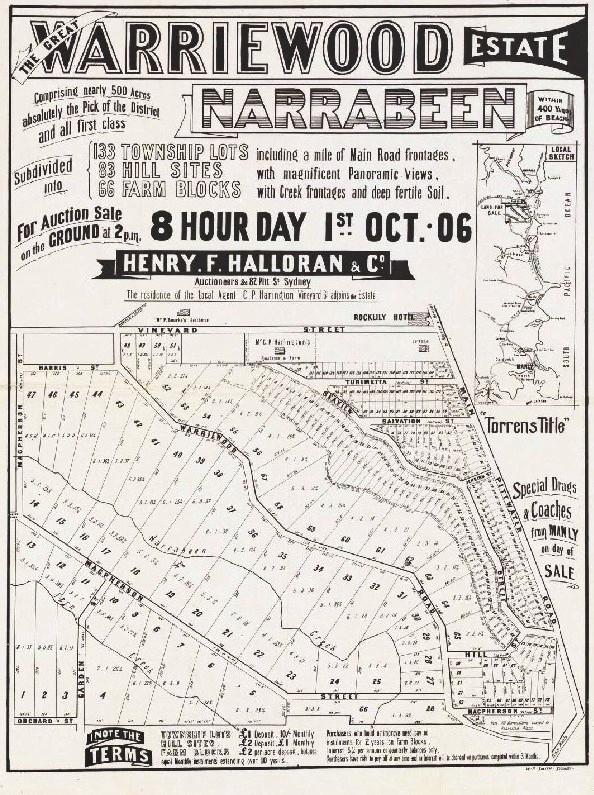
The great Warriewood Estate, Narrabeen, within 400 yards of beach [cartographic material] : for auction sale on the ground at 2 p.m. 8 hour day 1st Oct. 06 / Henry F. Halloran & Co., auctioneers & c 82 Pitt St. Sydney - from National Library of Australia; Sales plan for land in the suburbs of Mona Vale and Warriewood in Sydney, bounded by Vineyard Street, Main Pittwater Road, Turimetta Street, Salvation Street, Jenkins Street, Seaview Street, Hill Street, MacPherson Street, Warriewood Road, Harris Street, Garden Street, and Orchard Street.
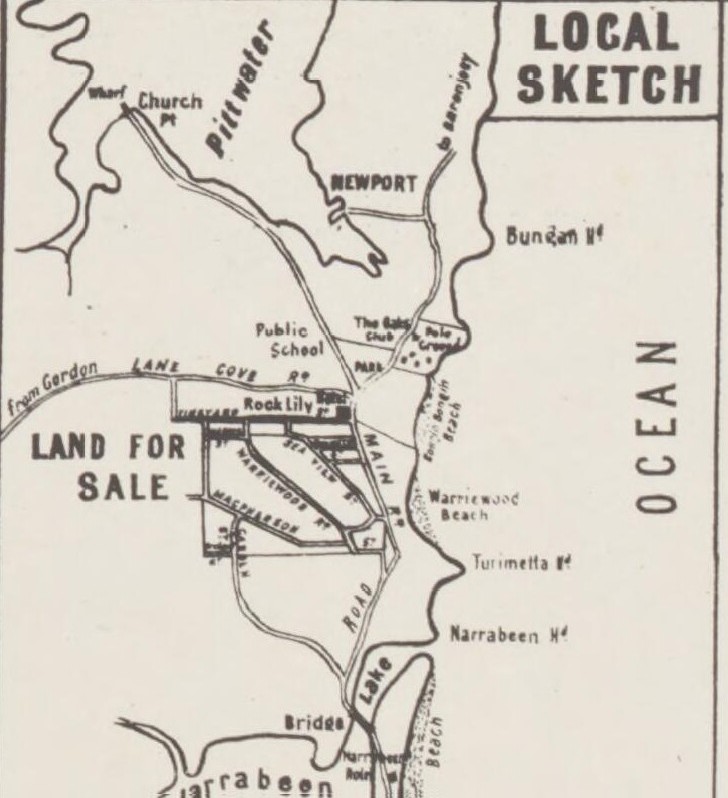
"Comprising nearly 500 acres, absolutely the pick of the district and all first class". "Subdivided into: 133 township lots including a mile of Main Road frontages, 83 hill sites with magnificent panoramic views, 66 farm blocks with creek frontages and deep fertile soil". "Torrens title". "Special drags & coaches from Manly on day of sale". "Note the terms: township lots £1 deposit, 10/- monthly; hill sites £2 deposit, £1 monthly; farm blocks £2 per acre deposit, balance equal monthly instalments extending over 10 years". "Purchasers who build or improve need pay no instalments for 2 years on farm blocks. Interest 5% per annum on quarterly balances only. Purchasers have right to pay off at any time and no interest will be charged on purchases completed within 3 months". Available online http://nla.gov.au/nla.obj-230339655
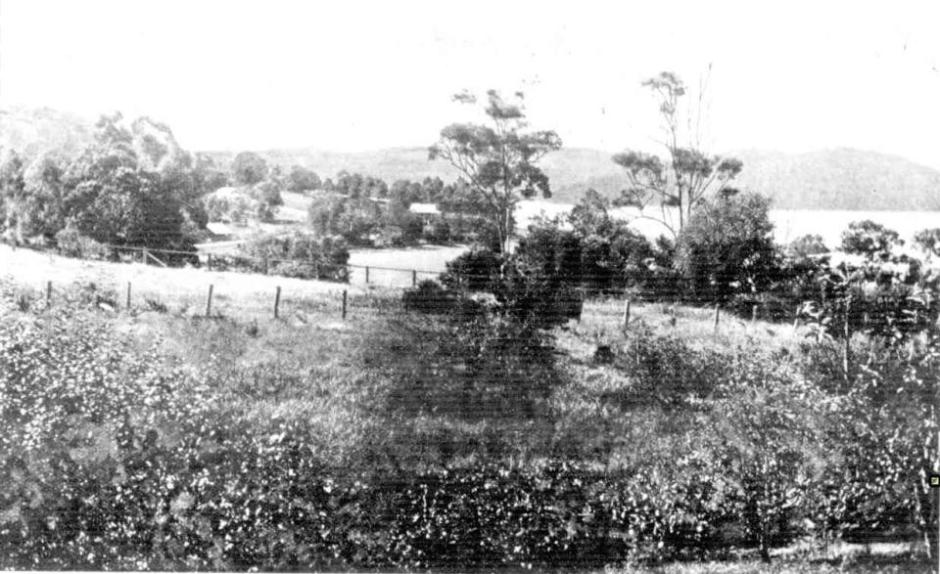
BAY VIEW, PITTWATER. AN IDEAL CAMPING GROUND, HAWKESBURY RIVER. A FAVOURITE HOLIDAY RESORT. (1903, December 30). The Sydney Mail and New South Wales Advertiser (NSW : 1871 - 1912), , p. 1706. Retrieved fromhttp://nla.gov.au/nla.news-article164902107
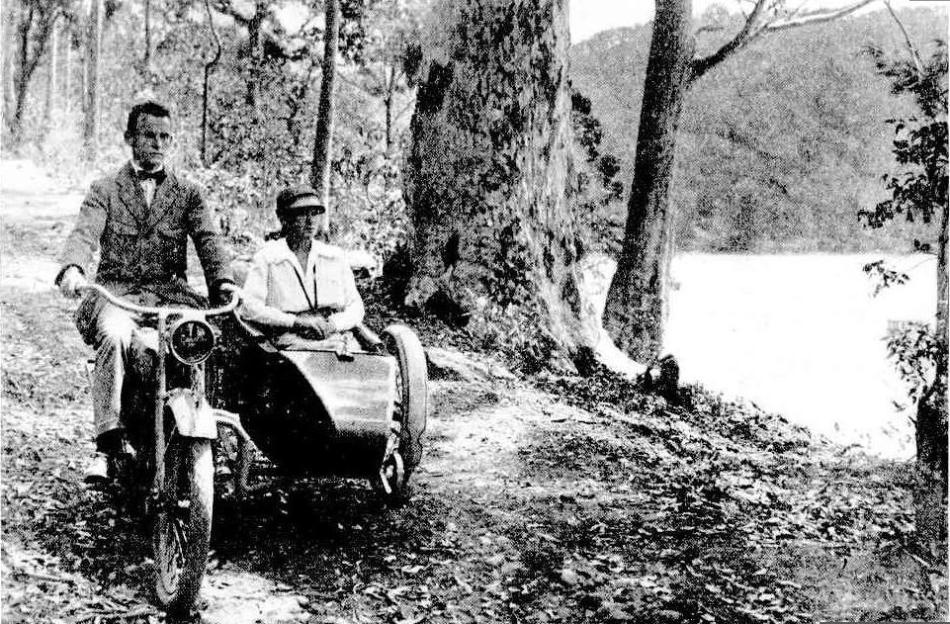
Along the foreshores of Broken Bay - 1918
The photograph was taken at Bayview , which overlooks lovely Pittwater, the southern part of Broken Bay* into which runs the beautiful Hawkesbury River . The whole of this locality is wonderfully rich in scenic charms. ALONG THE FORESHORES OF BROKEN BAY. (1918, January 23). Sydney Mail (NSW : 1912 - 1938), p. 5. Retrieved from http://nla.gov.au/nla.news-article159026429
Church Point and Bayview: A Pittwater Public School Set on the Estuary, 1880 to 2016 - A J Guesdon, 2016.
Previous History Pages:
Marie Byles Lucy Gullett Kookoomgiligai Frank Hurley Archpriest JJ Therry Sir Patrick Gordon Taylor Bowen Bungaree W. Bradley 1788 Journal Midholme Loggan Rock Cabin La Corniche La Corniche II Lion Island Bungan Beach Botham Beach Scarred Trees Castles in the Sand Dame Nellie Melba lunches at Bilgola Spring, 1914 First to Fly in Australia at North Narrabeen Mona Vale Golf Club's Annual Balls Governor Phillip camps on Resolute Beach Ruth Bedford Jean Curlewis Mollie Horseman Charlotte Boutin May Moore Neville W Cayley Leon Houreux Frederick Wymark Sir Adrian Curlewis Bilgola Heron Cove Mullet Creek Shark Point Woodley's Cottage A Tent at The Basin Collin's Retreat-Bay View House-Scott's Hotel Bilgola Cottage and House The First Pittwater Regatta Women Cricketers Picnic Filmed In Pittwater Governor Phillip's Barrenjoey Cairn Waradiel Season The Church at Church Point Governor Phillip's Exploration of Broken Bay, 2 - 9 March 1788 Petroglyths: Aboriginal Rock Art on the Northern Beaches Avalon Headland Landmarks Steamers Part I Pittwater Aquatic Club Part I Woody Point Yacht Club Royal Motor Yacht Club Part I Dorothea Mackellar Elaine Haxton Neva Carr Glynn Margaret Mulvey Jean Mary Daly Walter Oswald Watt Wilfrid Kingsford Smith John William Cherry George Scotty Allan McCarrs Creek Narrabeen Creek Careel Creek Currawong Beach Creek Bushrangers at Pittwater Smuggling at Broken Bay An Illicit Still at McCarr's Creek The Murder of David Foley Mona Vale Outrages Avalon Camping Ground Bayview Koala Sanctuary Ingleside Powder Works Palm Beach Golf Course Avalon Sailing Club Mona Vale Surf Life Saving Club Palm Beach SLSC Part I - The Sheds Warriewood SLSC Whale Beach SLSC Flagstaff Hill Mount Loftus Pill Hill Sheep Station Hill S.S. Florrie S.S. Phoenix and General Gordon Paddlewheeler MV Reliance The Elvina Florida House Careel House Ocean House and Billabong Melrose-The Green Frog The Small Yacht Cruising Club of Pittwater Canoe and I Go With The Mosquito Fleet - 1896 Pittwater Regattas Part I - Dates and Flagships to 1950 Shark Incidents In Pittwater The Kalori Church Point Wharf Bayview Wharf Newport Wharf Palm Beach Jetty - Gow's Wharf Max Watt Sir Francis Anderson Mark Foy John Roche Albert Verrills Broken Bay Customs Station At Barrenjoey Broken Bay Water Police Broken Bay Marine Rescue - Volunteer Coastal Patrol Pittwater Fire-Boats Prospector Powder Hulk at Towler's Bay Naval Visits to Pittwater 1788-1952 Pittwater's Torpedo Wharf and Range Naval Sea Cadets in Pittwater S.S. Charlotte Fenwick S.S. Erringhi P.S. Namoi S.Y. Ena I, II and III Barrenjoey Headland - The Lessees Barrenjoey Lighthouse - The Construction Barrenjoey Broken Bay Shipwrecks Up To 1900 Barrenjoey Light Keepers Douglas Adrian Ross Newport SLSC 1909 - 1938 Part I Overview North Narrabeen SLSC - The Formative Years Bilgola SLSC - the First 10 years North Palm Beach SLSC A History of Pittwater Parts 1 and 4 Pittwater Regattas - 1907 and 1908 Pittwater Regattas - 1921 - The Year that Opened and Closed with a Regatta on Pittwater Pittwater Regatta Banishes Depression - 1933 The 1937 Pittwater Regatta - A Fashionable Affair Careel Bay Jetty-Wharf-Boatshed Gow-Gonsalves Boatshed -Snapperman Beach Camping at Narrabeen - A Trickle then a Flood Pittwater's Parallel Estuary - The Cowan 'Creek' RMYC Broken Bay Boathouse and Boatshed Barrenjoey Boat House The Bona - Classic Wooden Racing Yacht Mona Vale Hospital Golden Jubilee - A Few Insights on 50 Years as a Community Hospital Far West Children's Health Scheme - the Formation Years The First Scotland Island Cup, Trophy and Race and the Gentleman who loved Elvina Bay Royal Motor Yacht Club Broken Bay NSW - Cruiser Division History - A History of the oldest division in the Royal Motor Yacht Club Royal Motor Yacht Club Broken Bay Early Motor Boats and Yachts, their Builders and Ocean Races to Broken Bay, the Hawkesbury and Pittwater The Royal Easter Show Began As the Royal Agricultural Society of New South Wales The Mail Route to Pittwater and Beyond The Wild Coachmen of Pittwater - A Long and Sometimes Bumpy Ride on Tracks Instead of Roads The Fearless Men of Palm Beach SLSC's Surf Boats First Crews - A Tale of Viking Ships, Butcher Boats and Robert Gow's Tom Thumb 'Canoe' Furlough House Narrabeen - Restful Sea Breezes For Children and Their Mothers From Telegraphs to Telephones - For All Ships at Sea and Those On Land Mona Vale Training Grounds - From Lancers on Horses to Lasses on Transport Courses Fred Verrills; Builder of Bridges and Roads within Australia during WWII, Builder of Palm Beach Afterwards Communications with Pittwater Ferries To Pittwater A History of Pittwater - Part 4: West Head Fortress Pittwater's Lone Rangers - 120 Years of Ku-Ring-Gai Chase and the Men of Flowers Inspired by Eccleston Du Faur Early Pittwater Launches and Ferries Runs Avalon Beach SLSC - The First Clubhouse Avalon Beach SLSC The Second and Third Clubhouses From Beneath the Floorboards at Hyde Park Barracks Bungaree Was Flamboyant Andrew Thompson - 'Long Harry' Albert Thomas Black John Collins of Avalon Narrabeen Prawning Times - A Seasonal Tide of Returnings Oystering in the Pittwater Estuary - Oyster Kings and Pearl Kings and When Not to Harvest Oysters Yabbying In Warriewood Creeks Eeling in Warriewood's Creeks (Includes A Short History of community involvement in favour of environmental issues/campaigns in and around Narrabeen Lagoon - 1974 to present by David James OAM) Eunice Minnie Stelzer - Pittwater Matriarchs Maria Louisa Therry - Pittwater Matriarchs Katherine Mary Roche - Pittwater Matriarchs Sarah A. Biddy Lewis and Martha Catherine Bens Pittwater Matriarchs Pittwater's New Cycle Track of 1901 Manly to Newport The Rock Lily Hotel Barrenjoey House The Pasadena Jonah's St Michael's Arch The First Royal Visitor to Australia: the Incident at Clontarf March 12th, 1868 Pittwater: Lovely Arm of the Hawkesbury By NOEL GRIFFITHS - includes RMYC Wharf and Clareville Wharf of 1938 + An Insight into Public Relations in Australia George Mulhall First Champion of Australia in Rowing - First Light-Keeper at Barranjuey Headland Captain Francis Hixson - Superintendent of Pilots, Lights, and Harbours and Father of the Naval Brigade The Marquise of Scotland Island The First Boat Builders of Pittwater I: the Short Life and Long Voyages of Scotland Island Schooner theGeordy Boat Builders of Pittwater II: from cargo schooners and coasters to sailing skiffs and motorised launches The Currawong: Classic Yacht The Riddles of The Spit and Bayview/Church Point: sailors, boat makers, road pavers and winning rowers VP Day Commemorative Service 2015 – at Avalon Beach RSL Cenotaph: 70th Anniversary Captain T. Watson and his Captain Cook Statues: A Tribute to Kindness Pittwater Reserves: The Green Ways; Hordern or Wiltshire Parks to McKay Reserve – From Beach to Estuary Pittwater Reserves, The Green Ways: Clareville Wharf and Taylor's Point Jetty Pittwater Reserves: The Green Ways Bilgola Beach - The Cabbage Tree Gardens and Camping Grounds - Includes Bilgola - The Story Of A Politician, A Pilot and An Epicure by Tony Dawson and Anne Spencer Pittwater Reserves - The Green Ways: Mona Vale's Village Greens a Map of the Historic Crown Lands Ethos Realised in The Village, Kitchener and Beeby Parks Pittwater Reserves: The Green Ways; Bungan Beach and Bungan Head Reserves: A Headland Garden Early Pittwater Paddlers, Oarsmen, Rowers and Scullers: The Green Family Elanora - Some Early Notes and Pictures The Stewart Towers On Barrenjoey Headland Early Pittwater Paddlers, Oarsmen, Rowers and Scullers: The Williams Family Early Cricket in Pittwater: A small Insight Into the Noble Game from 1880's On The Pacific Club's 2016 Carnival in Rio Fundraiser for Palm Beach SLSC Marks the 79th Year of Support Bert Payne Park, Newport: Named for A Man with Community Spirit Early Pittwater Paddlers, Oarsmen, Rowers and Scullers: The Fox Family Surf Carnivals in February 1909, 1919, 1925, a Fancy Dress Rise of Venus and Saving Lives with Surfboards Early Pittwater Paddlers, Oarsmen, Rowers and Scullers: The Paddon Family of Clareville Mermaid Basin, Mona Vale Beach: Inspired 1906 Poem by Viva Brock Early Pittwater Schools: The Barrenjoey School 1872 to 1894 The Royal Easter Show and 125th Celebration of the Hawkesbury Agricultural College: Farmers Feed Us! The Newport School 1888 to 2016 Pittwater's Ocean Beach Rock Pools: Southern Corners of Bliss - A History The Royal Botanical Garden Sydney Celebrates 200 Years in 2016 The Porter Family of Newport: Five Brother Soldiers Serve in WWI